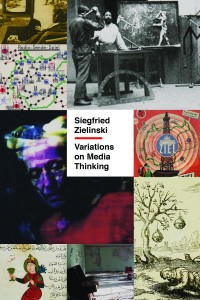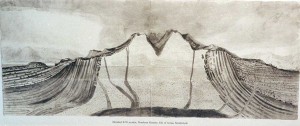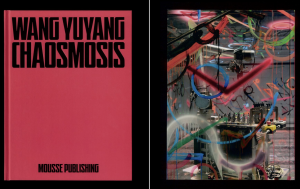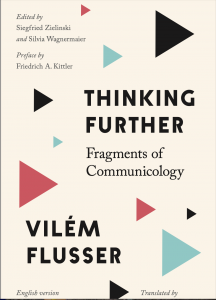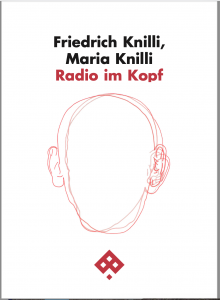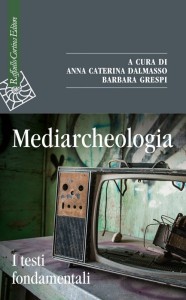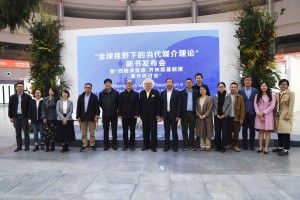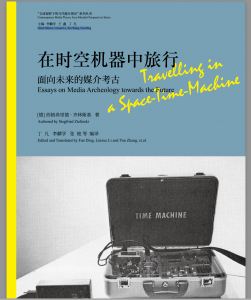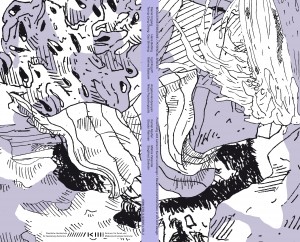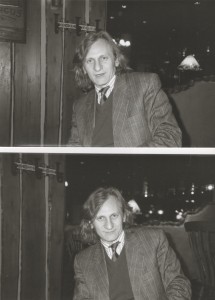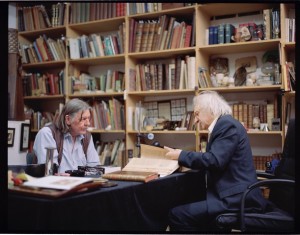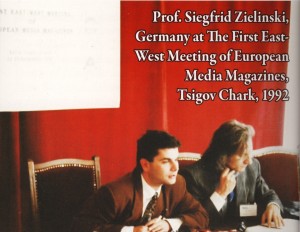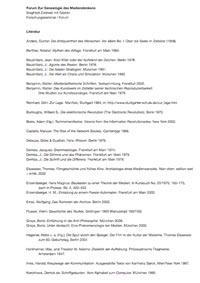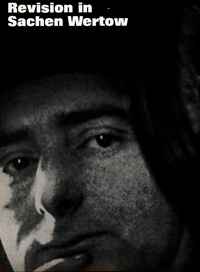Siegfried Zielinski
Professor emerit. for Archaeology & Variantology of the Arts & Media at Berlin University of Arts;
Michel-Foucault-Professor for Techno-Aesthetics and Media Archaeology at EGS Saas Fee (CH);
Guest Professor at Tongji University in Shanghai;
Prof. h.c., Dr. h.c. Budapest University of Arts.
contact: majaneu@gmx.de
Not a Wikipedia CV
Dates
Sunday, 7 December 2025 Tsinghua University Beijing
Reading Club/Workshop on the Chinese version of the Merve book
(… Art after the Media) – News from theOutfading 20th Century
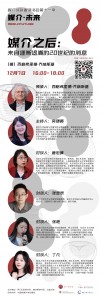
Tuesday 25 November Academy of Science & Arts Düsseldorf
Podium: Between Image and Language – Thinking in the Telematic Society
With Katrin Amunts (brain researcher) and Marion Poschmann (writer)
within the exhibition “überZeichnung” (8 Oct-12 Dec 2025)
Friday 28-11-2025 7 pm at ARTISTs PRESS
on the occasion of the finissage THE BEAUTY OF CHANCE
The Guest Room Dresdener Straße 10, 10999 Berlin-Kreuzberg
Friday 21-11-2025, 7 pm Buchhandlung König
Artificial Extelligence – A Short Manifesto
Reading (in German) and discussion with
Artists Press (Tom Fecht) und Christian Posthofen
Burgstraße 27, 10178 Berlin

7 November 2025, TU Berlin, Main building, Room H2036
Podium: “Anders Forschen und Lehren an der TU Berlin der 1970er und 1980er Jahre”
(in German)
8 October 2025, Berlinische Galerie (7:30 pm)
Catalogue Raisonné Publication
Podium for Chan Sook Choi’s new catalogue:
“The Non-Statistical Body”
mit Sooyon Lee, Jesi Khadivi, Young Bin Kwak
Distanz Verlag Berlin
26 June 2025, 7 pm , Berlin, Burgstraße
Buchhandlung Franz and Walther König
presentation of the book-catalog ART IN MOTION
and colloquium with authors, designers, ZKM, publisher
moderated by Christian Posthofen
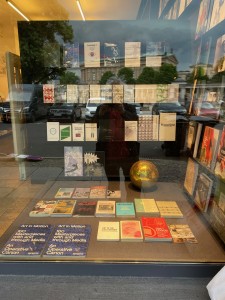
May 13, 2025 Arles/France
École nationale supérieure de la photographie
Lecture Re-Visiting Vilém Flussers Philosophy of Photography
(including a Manifesto on Artificial Extelligences)
Symposium “Playing Against the Apparatus – Flusser et l’art”
April 24, 2025 Museum of Modern Arts Bologna
Clandestine Talks – A project by Lara Favaretto
Thinking Head: PARADOX
April 23, 2025 University of Bologna, Dept. of Philosophy
Lecture Materiology & Variantology – Some Remarks
Host: Diego Donna
DiegoDonna_PoliticsTechnology_A3
October 31, 2024, Universität der Künste Berlin
Vortrag und Diskussion:
Freedom is not just another word for nothing left to loose
Colloquiumsleitung: Gesche Joost
October 13, 2024, CCCB (Barcelona)
Dancing Philosophy - A Dialogue in Music and Speech
with Anthony Moore and Siegfried Zielinski
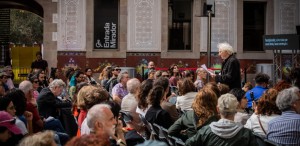
May 29/30, 2024 IVAM and Polytech
University Valencia (Spain)
Lecture/symposium on the art of Llorenç Barber
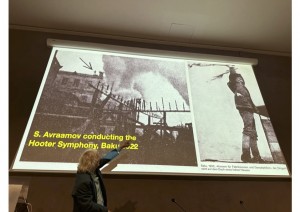
Foto: Lorenzo Sandoval
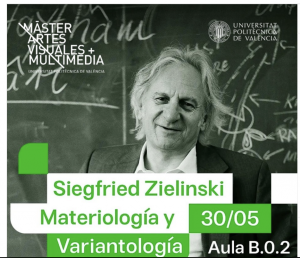
April 13, 2024 Karlsruhe ZKM (Centre for Art and Media)
Radio Free Modulations / Was kostet den Kopf?
Performance and discussion of new radio pieces by FM Einheit and Siegfried Zielinski
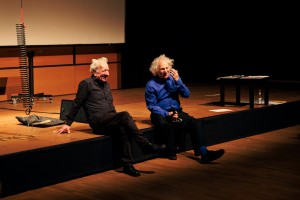
Foto: ZKM
April 28, 2024, Schloss (Castle) Wahn, Cologne
Opening speach for a symposium in honour of Werner Nekes’ 80th birthday
Followed by a two day symposium organized by the department for theatre at Cologne University
November 7-8, 2023 Shanghai, ZhangJiang High-tech Park
Keynote for the conference
Counter-Culture? Resetting all (im)possibilities of Technology
organised by the Institute of Network Society School of Inter-Media Art
(China Academy of Art, Hangzhou)
November 9-10, 2023 Tongji University Shanghai
Worshop with professors and researchers,
presentation of my new book on Mandarin
“Travelling in a Time Machine”, published by
Tongji University Press, Shanghai
October 2023, Tongji University
MATERIOLOGY & VARIANTOLOGY
Principles of thinking media and arts
in times of crises and radical upheavals
Video Lecture at the
Academic Forum Media Culture 2023
1 July, 2023 E-Werk Luckenwalde
Art station in Brandenburg
BURN OUT – Concert with FM Einheit & Band, with Rica Blunck
(Performance of songs SZ has written for FME)
May 31, 2023, Istanbul
Variantology & Travelling in a Time Machine –
The Work of Art in the Age of its Infinite
(Re)Producibility and Perceivability
Lecture at the Sabanci Museum
May 25, 2023, Dortmund
Presentation of the youngest radio pieces by FME & SZ
in the cinema U, invited by Marcel Marburger & Oliver Schwabe
March 26, 2023 ZKM Karlsruhe
Automata and Experimental Culture in the Early, Arabic-Islamic, Renaissance
Lecture for the Symposium on the Third Renaissance, organized by Peter Weibel
and the ZKM, Karlsruhe March 24-26
17.02.23 at 7:30 p.m. Berlin
An evening of sonic interception with FM Einheit & Siegfried Zielinski
im Club der Polnischen Versager, Ackerstrasse 169 10115 Berlin
Hosted by Aneta Panek
Zielinski&EinheitEngNeu
An artistic exchange between musician F.M. Einheit and media archaeologist Siegfried Zielinski span- ned two years, resulting in a critical and sonorous jumble of ideas – sometimes topical, sometimes
phantasmagorical, sometimes sound poetry.
“Art is resistance. There is no art without waste,” says Siegfried Zielinski. The researcher has been
studying media archaeologies and the function of archives for years. “Matter is active. It is subject, not object.”
Zielinski and the sound explorer F.M. Einheit accessed their “an archives” for Free Modulations Radio. The sounds they found inside were left to run rampant. A mental drift of quotations from Vilém Flusser to Genesis P-Orridge. Poetry of an artificial intelligence. The virus. The time. The apparatus. A montage of attractions.
With text fragments and voices from Antonin Artaud, Meret Becker, Walter Benjamin, Benjamin Bratton, William S. Burroughs, John Cage, Teodor Currentzis, F.M. Einheit, Vilém Flusser, Alexander Galloway, Alexander Hacke, Volker Kamp, Saskia von Klitzing, Georg Christoph Lichtenberg, David Link, Jennifer Minetti, Phil Minton, Alexander Moissi, Heiner Müller, Genesis P-Orridge, John Peel, Michael Saup, Henning Schmidgen, Werner Schwab and Siegfried Zielinski.
Production: Deutschlandfunk Kultur, “Klangkunst” (Marcus Gammel).
15 October 2022
Opening keynote for the 2022 Chinese Applied Journalism and Communication Forum
College of Arts and Media Tongji University of Shanghai
21 September, 2022
Jury International Film Festival Hong Kong
for best experimental films by students
Zuerich 8 June, 2022

becoming disposable -
towards an open operational concept of media.
Opening keynote speech for the conference
format : dispositif
format dispositif symposium program
*****
Copenhagen 6-8 April, 2022

“From the Unconditional ME to the Unconditioned WE”
conference Connect/Cut. Infrastructures and Collective Activity
Final_Program_Cut_Connect_2022
***
Shanghai Oct 30, 2021
Lecture: Some Short Reflections on
the City as a Space-Time-Machine
Conference New city:
Cultural Communication and Soft Power
Forum Tongji University
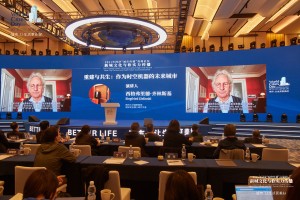
https://mp.weixin.qq.com/s/jMrZPxHfkEZJH20O9CW9Pw
Oct 29, 2021, ZKM Karlsruhe
Art Institutions in the Age of Existential Risks –
International Conference on the Future of Museums
Vortrag über Kunst-Institutionen
der Zukunft als “Surprise Generators”
https://zkm.de/de/veranstaltung/2021/10/art-institutions-in-the-age-of-existential-risks-what-to-do
October 28, 2021, Shanghai
(virtual lecture):
New Perspectives in Genealogy of Media Thinking Variantology & Prospective Archaeology
Annual Meeting of the Academy on the History of Communication Thoughts
Tongji University, Shanghai October 28/29, 2021
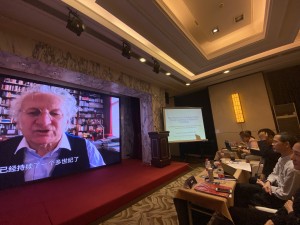
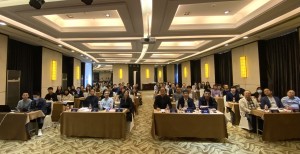
October 29, 2021, ZKM Karlsruhe
Art Institutions in the Age of Existential Risks –
International Conference on the Future of Museums
Lecture on “Surprise Generators”
https://zkm.de/de/veranstaltung/2021/10/art-institutions-in-the-age-of-existential-risks-what-to-do
October 17, 2021, Hamburg/Kunsthalle
Laudatio for Agnes Meyer-Brandis
Winner of the Kairos Award /Alfred Toepfer Foundation
August 8, 2021, Berlin
Siegfried Zielinski, Franziska Latell, Aneta Panek, Margit Rosen
Prospektive Archäologie vs. Globale Synchronisierung/Prospective Archaeology vs. Global Synchronisation
Podium at the Berlin Academy of Arts, Pariser Platz
Museums and archives are essentially time machines. Media thinker and archaeologist Siegfried Zielinski discusses the dystopia of a globally synchronised present and explores with his guests how (an)archives, collections and expositions can be related to each other as generators of surprise.
July 8/9 2021, Hamburg (no-place Zoom)
Die Kraft der Einbildung: Physiologie, Ästhetik, Medien
Workshop der Kolleg-Forschungsgruppe »Imaginarien der Kraft«
Lecture and dialogue – with Daniel Irrgang
May 5, 2021 – Kunsthochschule Dresden
in coop. with the Dresden Art Academy
Lecture “Operative Kanonisierung”
in den Künsten der Gegenwart (in German)
(verschoben)
March 9 – June 15, 2021, Istanbul
Exhibiting “Voices” from 22 episodes
of Radio FM – with FM Einheit

Dec 12, 2020, Shanghai
Forum at West Bund Art Centre Shanghai
Theme: Freedom & Control in Arts & Design (Education)
Place: West Bund Art Center Hall A (No. 2555 Longteng Avenue)
Online forum via Zoom and onsite
Chaired by Professor Xing Ruan and S. Zielinski
talks by Kristoffer Gansing, Andrès Burbano, Matteo Pasquinelli and David Link
Comments and Questions:
Prof. Xing Ruan and Dean Ilaria Valente (Turino)
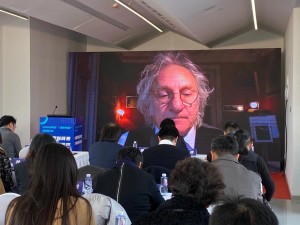
*****
December 12, 2020, Shanghai
Tongji University – International Forum on Urban Communication
Video-Lecture:
Heterotopic Places – The City as a Stage
or: Materialism of Encounters
*****
Nov 15, 2020, Beijing
OCAT-Festival Beijing
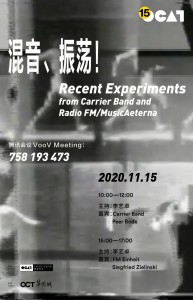
Broadcasting of VIRUS – episode #2 of the acoustic series on MusicAeterna,
St. Petersburg. Additionally FME and SZ are present in Video & Audio:
https://mp.weixin.qq.com/s/bMznea9kA5nN019KHu9V5Q
Nov 6-7, 2020 – Nam June Paik Art Center Seoul
Living in the Postdigital, Reliving the Museum
Keynote Lecture on Paik and the museum of the future
(text contribution) and audiovisual statement
symposium leaflet
(offline lecture postponed to 2021)
Nov 4-6, 2020 – International Film School Hong Kong
Global Film Award for Film Schools
Jury for experimental film, Award presenter

Master Class for Students of the IFS Hong Kong
on Expanded Animation postponed to spring 2021
October 02-04, 2020 – Lviv, Ukraine
“The Shy Machines” – The Futurological Congresswhich
Keynote (postponed)
September 4, 2020, Berlin
Opening of the exhibition IN ABSENTIA at
KUNSTHALLE KOIDL Berlin-Charlottenburg
cur. by Walter Lenertz
Dieter Appelt, The Brothers Quay, FM Einheit,
Walter Lenertz, Wolfgang Petrick, Rebecca Raue,
Peter Weibel, Siegfried Zielinski, Thomas Zipp

July 25 – 31, 2020 – Bergamo Art University
Summer classes for the European Graduate School
on Variations on Media Thinking
(Together with Slavoj Zizek)
Will take place as a telematic seminar!
July 10-12, 2020 – Eindhoven, ICOHTEC
International Committee for the History of Technology (UNESCO)
Summer School Seminar
(postponed)
May 11, 2020 – UCLA, Los Angeles
Symposium/book presentation:
Art for the 21st Century – Provocations and Reflections
with Masaki Fujihata, hosted by Erkki Huhtamo and osage Hong Kong)
April 19, 2020 – Schauspielhaus Hamburg
Laudatio auf die Künstlerin Agnes Meyer-Brandis
Europäischer Kulturpreis KAIROS der Toepfer Stiftung
(cancelled/postponed)
April 3 – Baptiste University Hong Kong
Jury and Presenter for the Global Award for Student Films
April 2 – International Film School Hong Kong
Masterclass on Expanded Animation
(postponed to Nov 4-6, 2020)
Feb 20 – March 20, 2020, Beijing
(postponed!)
Art in Motion – 100 Master Pieces With & Through Media – An Operational Canon,
curated by Peter Weibel and Siegfried Zielinski for the ZKM Karlsruhe in 2017/18, will be exhibited in a different format in the framework of CAFAM Techne Triennial, directed by ZHANG GA (张尕) for the CAFA Art Museum in Bejing.
CAFA Art Museum, Beijing, China www.cafamuseum.org/en/
Dec 13, 2019 – Istanbul
Keynote on Preservation of Techno-beased Arts
Conference at Sabanci Museum Istanbul (hosted by Sabanci Museum and University, Selcuk Artut, Faculty Arts & Design)
Dec 10, 2019 - Ljubljana
SCCA-Ljubljana
Torek, 10. december 2019, 18.00
Moderna galerija, Cankarjeva 15, Ljubljana
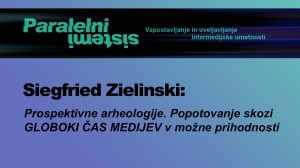
Lecture on PRO-SPECTIVE ARCHAEOLOGIES. Travelling through DEEP TIME OF THE MEDIA – from the Past to the Future.
http://www.scca-ljubljana.si/siegfried-zielinski-prospektivne-arheologije/
Dec 2-3, 2019 – Beijing
Media Archaeologies – A 2 days conference at Peking University (School of Fine Arts) with Thomas Elsaesser and Siegfried Zielinski
The symposium includes the screening of an early project on experimental archaeology of the media, which Siegfried Zielinski had produced in 1992 at the University of Salzburg (with Alois Pluschkowitz):
100 – 20 Short Films Towards an Archaeology of Audiovisions
https://www.sohu.com/na/357952371_100048878?scm=1002.45005a.15d015e01a3.PC_NEW_ARTICLE_REC&spm=smpc.content%2Fnew.fd-d.8.1575244800026oXoZw5N
Nov 29, 2019 – Tongji University of Shanghai
Evening Lecture on Pro-Spective Archaeologies
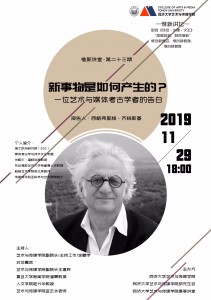
Poster: Nikita Lin
Nov 26-27, 2019 - Shanghai
Non-trivial Relations Between Arts and Sciences.
A 2-day Forum organised by the Shanghai Art School at Westbund, initiated and directed by Siegfried Zielinski as part of the FutureLab Shaghai – on world wide developments of Academies/Universities for Art and Design
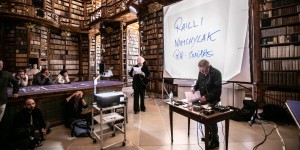
Credit: vog.photo
Anthony Moore (UK/FR), Siegfried Zielinski (DE)
Walking Lectures: Calculated Sensation
Ars Electronica Linz, 2019
Earlier in 2019 Siegfried Zielinski presented his variations on media thinking in lectures, seminars, colloquia in Abu Dhabi, Austin (US), Berlin, Frankfurt/Main, Hong Kong, Houston (US), Karlsruhe, Lausanne (CH), Linz (A), Saas Fee (CH), San Marco (US), Shanghai, Shenzhen, Talahassee (Florida), Teheran, Washington and Zagreb.
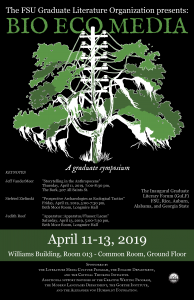
Strassbourg 2018 : Manifesto conference:

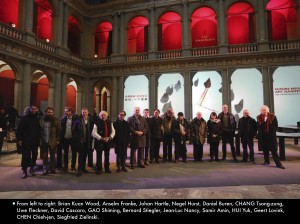
*****
Lecture at the Central Academy of Fine Arts, Beijing
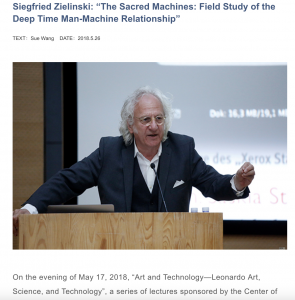
*****
For the many activities and events between 2015 and 2018,
please, see the websites f.e. of the Berlin University of Arts
and the Karlsruhe University of Arts & Design (HfG)
Past Events within the forum on genealogy of MediaThinking:
24.10.12
Prof. Dr. Peter Weibel Vienna / Karlsruhe
Media theorist, artist, curator, director of ZKM Karlsruhe
Link to Prof. Dr. Peter Weibel’s Biography
07.11.12
Prof. Dr. Joachim Paech Konstanz / Berlin
Media and film theorist
Website of Prof. Dr. Joachim Paech
21.11.12
Prof. Dr. Thomas Elsaesser Berlin / London / Amsterdam
Film and media critic, historian and theorist, co-founder of the Amsterdam School of Cultural Analysis (ASCA)
Website of Amsterdam University
05.12.12
Florian Rötzer Munich / Telepolis
Art critic, writer, artist, editor
Articles by Florian Rötzer on heise.de
A portrait by »tagesspiegel«
16.01.13
Prof. Dr. Elisabeth von Samsonow Vienna
Philosopher, artist, media researcher
Website of the Academy of Fine Arts Vienna
30.01.13
Prof. Dr. Hans-Ulrich Reck Basel / Cologne
Art historian, philosopher and media theorist, curator
Website of the Academy of Media Arts Cologne
13.02.13
Prof. Dr. Boris Groys New York
Art and media theorist, curator, cultural philosopher
Website of HFG Karlsruhe
Website of New York University
25.04.13
Prof. Dr. Hans Belting Karlsruhe / Berlin
Art and media theorist, art historian, curator
Bibliography of Hans Belting on the ZKM website
Hans Belting’s biography on GAM – Global Art and the Museum
02.05.13
Prof. Dr. Wolfgang Ernst Berlin
Media theorist, archaeologist, archive theorist
Website of Humboldt-University Berlin
16.05.13
Prof. Dr. Hartmut Winkler Paderborn
Media theorist
Website of Paderborn University
30.05.13
Prof. Dr. Henning Schmidgen Regensburg
Historian of science and technology, Professor for media aesthetics; time machine specialist
Website of Regensburg University
13.06.13
Prof. Dr. Claus Pias Lüneburg
Media theorist, philosopher of the digital; cybernetics specialist
Website of Leuphana University
04.07.13
Prof. Dr. Sybille Kraemer Berlin
Philosopher – with focus on phenomena of media and communication
Website of the Free University Berlin
18.12.13
Prof. Dr. Nils Röller Zurich
Professor for Media- and Culture theory at the HGKZ (Academy for Design and Art) Zurich
Website of the Institute for Contemporary Art Research
Website of the Journal für Kunst, Sex und Mathematik
15.01.14
Prof. Dr. Knut Ebeling Berlin
Professor for media theory and aesthetics at the Berlin Weissensee School of Art
Website of Berlin Weissensee School of Art
08.05.14, 6-8 pm
Prof. Dr. h.c. VALIE EXPORT Vienna
Artist
Website of VALIE EXPORT
02.07.14, 7-9 pm
Geert Lovink Amsterdam
Media theorist and activist
institute of network cultures
09.07.14, 7-9 pm
Prof. Dr. Otto Rössler Tübingen
Chaos theorist, biochemist, endophysicist
excerpt from “Variantology: Einstein Bohr Battle Confirms Everett’s Eternal Now”
The Forum on the Genealogy of MedieaThinking essentially lived through the contributions of the many students at the University of the Arts Berlin, who participated in the project.
For their contributions as authors, photographers and designers as well as for the technical support, sound recordings and transcription of the panels, we would like to thank: Anna Beykirch, Noemi Cipollone, Gerald Dissen, Julia Ebert, Marius Förster, Konstantin Daniel Haensch, Maria Meermeier, Inger Neick, Maria-Elisabeth Niebius, Katharina Papke, Mathias Paul, Kristina Paustian, Sebastian Prassek, Robert Preusse, Stefanie Rau, Julia Schmidt and Eva Zahneißen, as well as Anita Ackermann, Steve Bergmann, Philip Bresinsky, Elisa Storelli and Philipp Tögel.
Variations on Media Thinking
Published as vol. 52 of the Posthumanities series ed. by Cary Wolfe
(Minneapolis: University of Minnesota Press, 2019)
Review of SZ’s Variations on Media Thinking – symploke 2020
http://neural.it/2021/04/siegfried-zielinski-variations-on-media-thinking/
Expanding on Siegfried Zielinski’s groundbreaking inquiry into “deep time” of the media, these essays foster the eminent media theorist’s unique method of expanded hermeneutics, which means for him interpreting technical artifacts as essential parts of our cultural lives. Including many previously untranslated and scarce essays, these “written time machines” further diversify Zielinski’s insight into the hidden layers of media development.
The oldest essay, which has been translated for this book, has been written in a first version in 1975. Its topic is the Worker’s Radio Movement (Arbeiter-Radio-Bewegung) in the Weimar Republic, to which one can refer as the first Hacker’s movement in the 20th century. In the German original it was only published in the first two editions of the catalogue >>Wem gehört die Welt?<< (Who Owns the World?), for the following editions it suffered censorship and was not included anymore. – The latest text is Allah’s Automata, written for the exhibition with the same title, hosted by the Centre for Art and Media Karlsruhe (ZKM) in 2015.
Historians of technology know that any tool is also an instrument of exploration, experiment, and simulation. Siegfried Zielinski reminds us that any technology is also a generator of wonder. In fact, Zielinski does not write media history, he writes world history through the generative lens of media as machines of speculation and imagination. This is a material history of dissent, heretical hermeneutics, and electrified alchemic curiosity.
(Matteo Pasquinelli)
***
xxx
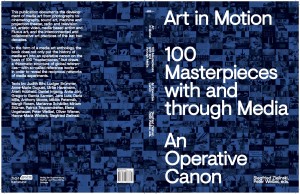
Catalogue for the exhibition “Art in Motion…”
at the ZKM Karlsruhe (2018), edited with Peter Weibel
Published by ZKM in cooperation with
Franz and Walther Koenig, Cologne, 2025
Texts by Judith Bihr, Ulrike Havemann, Anett Holzheid, Daniel Irrgang,
Anita Jóri, Jens Lutz, Daria Mille, Miklós Peternák, Margit Rosen,
Miriam Stürner, Patrick Trappendreher,
Peter Weibel, Siegfried Zielinski and others
y
++++++++
***
***
+++++
Siegfried Zielinski
ARTIFICIAL EXTELLIGENCE
A Short Manifesto
ARTISTs PRESS Basel–Berlin-Geneva
Brochure / 48 pages / 21×13 cm / 8 color plates
Bilingual English/German Edition
ISBN 978-3-949990-04-5
Initial distribution: 31 October 2025
***
***
DEEP TIME (2025)
contribution for the
ENVIRONMENTAL HUMANITIES GLOSSARY
University of Copenhagen/Dept. of ARts and Cultural Studies
https://artsandculturalstudies.ku.dk/research/art-and-earth/environmental-humanities-glossary/deep-time/
John Clerk of Eldon 1788 in “James Hutton’s Theory of theEarth:
The Lost Drawings. Royal Geological Society of London, 1978
***
***
***
Wang Yuyang: Chaosmosis
The catalogue Wang Yuyang: Chaosmosis follows the eponymous exhibition held at
Shenzen Art Museum, curated/edited by Zhang Ga
Texts by Rudolf Frieling, Mark B. N. Hansen, Caroline A. Jones, Zhang Ga, Siegfried Zielinski
Mousse Publications, Milano 2025
***
***
***
Selection of texts from what in German is called
Bochumer Vorlesungen – Kommunikologie weiter denken.
Publication planned for January 2026
Minnesota University Press
***
***
***
*
VIENNA, Passagen 2025
Mit einem Essay von Siegfried Zielinski:
“Friedrich Knilli – Medienpionier,
Überraschungsgenerator, Anarchist, Unternehmer”
Zeichnungen: Lena Knilli
*
***
***
*
ARTNODES (Barcelona)
E-Journal on Art, Science, and Technology publishes node #34 (July 2024)
MATERIOLOGY AND VARIANTOLOGY: INVITATION TO DIALOGUE
edited by Siegfried Zielinski & Daniel Irrgang
https://doi.org/10.7238/artnodes.v0i34.431116
with contributions by:
Peter Blegvad
Arianna Borrelli
Amador Vega
David Link
Miklos Peternak
Benoît Turquety
Lorenzo Sandoval
Marcel René Marburger
Aaron Jaffe
Rosa Barba
Hongfeng Tang
Florian Cramer
Erkki Huhtamo
Pedro J S Vieira de Oliveira
Tin Wilke
Mário Gomes
Margit Rosen
Carolina Arévalo, Bettina Korintenberg
Paolo Patelli, Jussi Parikka
Ebru Kurbak
Aneta Panek
Mauricio Vásquez Arias
Ricardo Sarmiento Gaffurri
Tomáš Dvořák
Jordi Sánchez-Navarro
Carolina Fernández-Castrillo
Paola Torres Núñez del Prado
*
***
I TESTI FONDAMENTALE
A new reader in Italian language, with texts by
Andrea Mariani, Wolfgang Ernst, Erkki Huhtamo, Friedrich Kittler,
Yussi Parrika, Siegfried Zielinski and others.
Milano: RAFFAELA CORTINA EDITORE, 2024
*
***
*
Dendrites and some fundamental questions. A conversation between Juliane Henrich, Siegfried Zielinski, and GPT-4 about Novalius and a video installation. In: Resonant Spaces/Resonanzräume, Katalog, Wiesbaden: Nassauischer Kunstverein, English 2025, German 2023, 24-39
in a modified variation printed as:
Juliane Henrich, Siegfried Zielinski, with GPT-4, and Friedrich von
Hardenberg aka Novalis
Crystallographic Resonances: Rewriting Novalis
In: Technology and Language #122, Future Writing
Peter the Great St. Petersburg Polytechnic University
***
http://openthresholds.org/howtonavigate
https://lareviewofbooks.org/article/unabashed-tour-dhorizon-media-20th-century/
***
***
During the Shanghai Biennale and Art Fair in November 2023 Tongji University Press presents three books with texts by Siegfried Zielinski translated into Chinese Language:
GENEALOGY OF MEDIA THINKING
(ed. by Florian Hadler and Daniel Irrgang)
(… AFTER THE MEDIA – NEWS FROM THE OUTFADING 20TH CENTURY
TRAVELLING IN A SPACE-TIME MACHINE
(a collection of essays and lectures compiled especially for a young readership in China):
***
https://www.ardaudiothek.de/episode/swr2-essay/das-schallspiel-entsteht-wenn-draehte-klingen-friedrich-knilli-und-sein-medienbegriff/swr2/12854809/
(First broadcast: 29 October 2023)
Shortly before Friedrich Knilli died in 2022, his daughter, filmmaker Maria Knilli, had a long conversation with him. She gave it the title “Radio in the Head”. In this SWR 2 radio essay, Götz Naleppa and Siegfried Zielinski react to Knilli’s provocative ideas. Naleppa worked with Knilli for many years as a radio artist. Zielinski studied under Knilli and together they developed the first degree programme for media studies and media consulting at the TU Berlin.
***

Radio Boy in a British train (ca 1930)
New cooperations with FM Einheit:
RADIO FREIE MODULATIONEN -Radio Art for
Deutschlandfunk, the central German radio station:
https://www.hoerspielundfeature.de/radio-freie-modulationen-100.html
“Was kostet den Kopf? – Eine Ringschaltung”
Radio Art – ReVisiting the so called first Russian Avantgarde
https://www.ardaudiothek.de/episode/swr2-hoerspiel/fm-einheit-und-siegfried-zielinski-
was-kostet-den-kopf-eine-ringschaltung/swr/12686489/
*****
FM module/ on MusicAeterna,
Teodor Currentzis’ platform as part
of an artist in residence program
in St. Petersburg
Together with FM Einheit’s large network of artists like Andreas Ammer, Alexander Hacke, David Link, Genesis P-Orridge, Caspar Broetzmann, Mona Mur, Katharina Franke, Stuckie and many others FM Einheit and Siegfried Zielinski develop in this project an unusual acoustic format. Between Ars Acoustica, radio play, acoustic Lehrstück, Schallspiel, poetry, our living archives and philosophical thought, a cosmos of sensual-reflexive experience is created – exclusively for listening. 25 programs have been created until the cooperation was stopped because of Putin’s aggressive war against the Ukraine:
https://musicaeterna.world/en/?id=363 https://www.youtube.com/watch?v=K_keSV279PA – VIRUS https://musicaeterna.world/en/?id=369 https://musicaeterna.org/en/?id=372 https://musicaeterna.org/en/media/fm_5_resistance/
https://musicaeterna.org/en/media/fm_9_schnittstelle_interface_1/ https://musicaeterna.org/en/media/fm_10_schnittstelle_interface_2/ https://musicaeterna.org/en/media/fm_11_ocean/ https://musicaeterna.org/media/fm_modul_14_prikosnovenie/ https://www.youtube.com/watch?v=e9rLxufUew4 https://musicaeterna.org/en/media/fm_module_17_freedom/ https://www.youtube.com/watch?v=HcoM7aJA9UY – (skin) https://soundcloud.com/radio_musicaeterna/fm-module-21 https://www.youtube.com/watch?v=LXvMehtHqq8 https://www.youtube.com/watch?v=2yXIo2hDTIM https://www.youtube.com/watch?v=9uTMWaH89ps
***
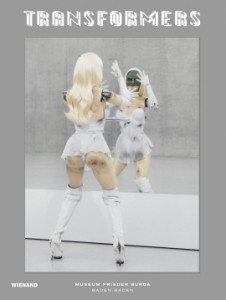
“Frivolous Beings – When Artifacts Become Subjects”
Essay in Udo Kittelmann’s exhibition catalogue TRANSFORMERS for Museum Frieder Burda, Wienand 2023
*****

“Between Res Cogitans and Res Extensae -
A Short Portrait of the Artist Yunchul Kim”
Essay im Ausstellungskatalog des Künstlers Yunchul Kim, der 2022
den koreanischen Pavillonauf der Biennale von Venedig bespielt hat.
***
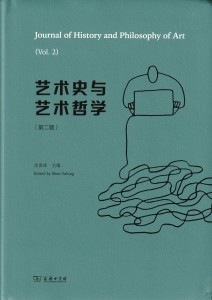
The Journal of History and Philosophy of Art at Fudan University in Shanghai publishes some of the lectures from the symposium POESIS AND PRECISION, which Siegfried Zielinski curated in 2019, including my text on Art and Science as Practised Culture of Experiment.
Editor of the Journal (Vol. 2) is Shen Yubing from Fudan University 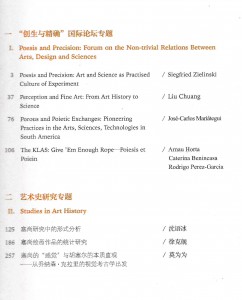
*****
In honor of artist Yunchul Kim’s exhibition in the Korean Pavillon at the 2022 Venezia Berlinale a large catalogue has been published by Hwasun L. Barakat in Seoul. Besides Kim’s texts the catalogue also includes Siegfried Zielinski’s Portrait of the artist as a contemporary materiologist:
Between Res Cogitans & Res Extensae
*****

Cologne: Halem publishers 2022
Ed. with Hans Ulrich Reck
***
New Reader on Vilém Flusser:
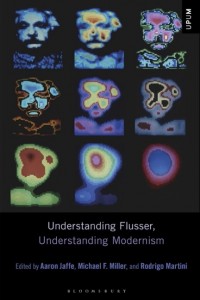
UNDERSTANDING FLUSSER, UNDERSTANDING MODERNISM
Ed. by Aaron Jaffe, Michael F. Miller, and Rodrigo Martini
(New York: Bloomsbury 2021-22)
Siegfried Zielinski has written the epilogue: Between Languages and Without Discipline – A
20th Century Intellect Drafted for the 21st Century
***
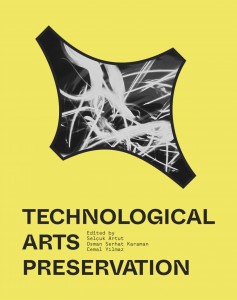
SSM_TechnologicalArtsPreservation-rf
Siegfried Zielinski on PROSPECTIVE ARCHAEOLOGY
Printed version published Istanbul 2022
(Lecture atSakıp Sabancı Museum Istanbul)
***
NEW: March 2020
Book launch: www.hkact.hk/act6
Art in the 21st Century – Reflections & Provocations
Editors: Siegfried Zielinski, Charles Merewether Contributing Editor: Masaki Fujihata Managing Editor: Agnes Lin osage Publishers Hong Kong www.osagepublications.com https://www.hkact.hk/act6
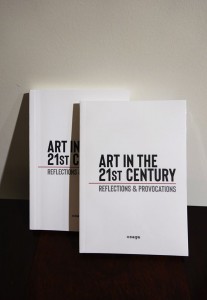
Contributions by
JAMIE ALLEN, HANS BELTING, SUZANNE BUCHAN, TIMOTHY DRUCKREY, ANNE-MARIE DUGUET, MASAKI FUJIHATA, YUK HUI, HIDETAKA ISHIDA, HIROAKI KITANO, SCOTT LASH, AGNES LIN, CHARLES MEREWETHER, KENJIRO OKAZAKI, ANDREY SMIRNOV, BERNARD STIEGLER, PETER WEIBEL and SIEGFRIED ZIELINSKI
***
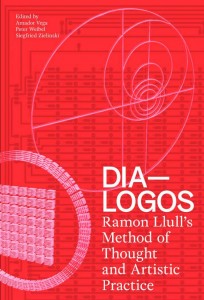
Amador Vega, Peter Weibel, Siegfried Zielinski (eds.)
The University of Minnesota Press, Minneapolis, 2019
The life and work of the outstanding Catalan-Majorcan philosopher, logician, and mystic Ramon Llull continues to fascinate thinkers, artists, and scholars worldwide. The primary idea of Ramon Llull’s teachings – to enable rational and therefore trustworthy dialogue between cultures and religions through a universally valid system of symbols – is today still topical and of great relevance, especially in the tensions prevailing in globalized spaces of possibility. In this book, international experts address Lullism as a remarkable and distinctive method of thinking and experimenting.
Review Leonardo
ISBN 978-1-5179-0609-2
Production / Corporation / Exhibition : ZKM | Center for Art and Media Karlsruhe
Partners: Centre de Cultura Contemporània de Barcelona – CCCB École polytechnique fédérale de Lausanne – EPFL Gestaltung: operative.space (Robert Preusse & Stefanie Rau)
***
Daniel Irrgang, Siegfried Zielinski (Hg.):
Potential Spaces – Research and Teaching in Art and Design
Bilingual German/English ISBN 978-3-928201-58-2
On the occasion of the 25th anniversary of the Staatliche Hochschule für Gestaltung (HfG) Karlsruhe, researchers from all corners of the globe transformed the art and design university and its sister institution, the ZKM | Zentrum für Kunst und Medien Karlsruhe, into a space of possibility for manifold futures of research and teaching in art and design for a few days. As with the founding of the HfG, the most important gesture was not retrospective but prospective. The Potential Spaces conference (16-18 February 2017) served as a provisional framework that temporarily brought together the assembled diverse perspectives from the arts, art studies, media theory, philosophy, pedagogy and critical theory, yet allowed them to unfold in their diversity. For instead of dictating a new master narrative for research and teaching in a Western-constructed globality, it was precisely the concern of Potential Spaces to use the synergies and dissonances between positions from different disciplines, methods and cultural contexts and to keep them in productive vibration.
Karlsruhe University for Art and Design / Centre for Art and Media (ZKM) Karlsruhe
*****
Ernst Kapp
Elements of a Philosophy of Technology
On the Evolutionary History of Culture
Translated by Lauren K. Wolfe Afterword by Siegfried Zielinski
Edited by Jeffrey West Kirkwood and Leif Weatherby
Elaborated philosophical thoughts about technics and technology in Germany did neither start with Martin Heidegger nor did they end end with him. Compared with previous and contemporary philosophers Heidegger was conservative and basically retro-spective with his ideas on technics and technology. In 1877 German philosopher Ernst Kapp published his Grundlagen einer Philosophie der Technik. Initiated by Cary Wolfe and Siegfried Zielinski University of Minnesota Press translated Kapp’s eminent text and published it recently as Elements of a Philosophy of Technology (2019). The book was translated by Lauren K. Wolf. Siegfried Zielinski wrote an Afterword. This is how it concludes:
“Kapp’s concept acquires the power of innovation via the gesture inherent to it of a propulsive dreaming, via the Art of the Possible that Kapp so fascinatingly knows how to describe. It is for this quality that he has become over the past 140 years an important reference point in both the history and the philosophy of technology, which are not only deeply interwoven with one another but also with variants of a materiologically engaged media studies. I am convinced that, with this newly available translation, Kapp’s ideas and concepts—like organ projection or the state as disciplinary machine comprised of parts functioning in circular full-closure—will enter and fortify the international field of media studies as well as, and more so, the more comprehensive field concerned with thinking the relationship of technology and civilization.”
Ernst Kapp, Elements of a Philosophy of Technology: On the Evolutionary History of Culture (Minneapolis: University of Minnesota Press, 2019)
https://www.upress.umn.edu/book-division/books/elements-of-a-philosophy-of-technology
***

 Russian edition of Archaeologie der Medien (2002) / Deep Time of Media (2006)
Published by GARAGE - AdMarginem, Moscow 2020
***
Russian edition of Archaeologie der Medien (2002) / Deep Time of Media (2006)
Published by GARAGE - AdMarginem, Moscow 2020
***
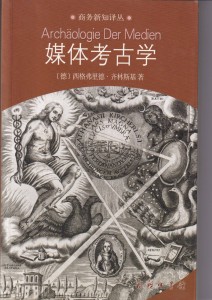 Archäologie der Medien / Archaeology of Media
Second edition of the Chinese translation
Publisher: The Commercial Press Beijing, 2019
***
Archäologie der Medien / Archaeology of Media
Second edition of the Chinese translation
Publisher: The Commercial Press Beijing, 2019
***
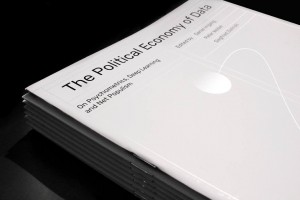
“The Political Economy of Data. On Psychometrics, Deep Learning and Net Populism” ed. by Daniel Irrgang, Peter Weibel and Siegfried Zielinski
Design: Mio Kojima & Tatjana Pfeiffer
ZKM | Center for Art and Media Karlsruhe & Karlsruhe University of Arts and Design (HfG) Karlsruhe, 2018.
more information on: http://danielirrgang.net/ *****
Radio Play Live in Brno/Tschechien (2017)
Symphony of Sirens
A Re-Enactment
- ARD-alpha 15.07.2018, 21:00 Uhr, 47 Min
Die “Symphony of Sirens” by Russian composer Arsenij Avraamov is the loudest piece of music ever produced and performed. When it was performed the first time in Baku in 1922 the whole city was invited to join actively the concert: with canons, locomotives, sirens of ships and factories, machine-guns, aeroplanes, and huge choires with young people. Andreas Ammer and FM Einheit reconstructes this milestone of the Avantgarde and performed it in Brno in October 2017. With Saskia von Klitzing, Jon Sass, Pavel Arakelian, Andreas Ammer, FM Einheit, Jan Sedal and Siegfried Zielinski (as Avraamov) Others: Chöre aus Brünn, Frajárenka Brass Band, Volker Kamp Blaskapelle, Fanclub des HC Kometa Brünn, Baterie Austerlitz sowie Feuerwehr- und Krankenwagen aus Brünn / Ton und Technik: Thomas Stern, Radek Odehnal, FM Einheit, Fabian Zweck / BR/Philharmony Brno in Cooperation withDeutschlandradio, 2018 *****
***
The Art of Cooking: We might eat with our eyes – but we are cooking with our ears
Radio play ARS ACOUSTICA WDR Cologne FM Einheit and Siegfried Zielinski Two men spend a day in the kitchen. Intuitively they mix various ingrediencies with thoughts and quotes – and with music. Because cooking is like composing- nearly…
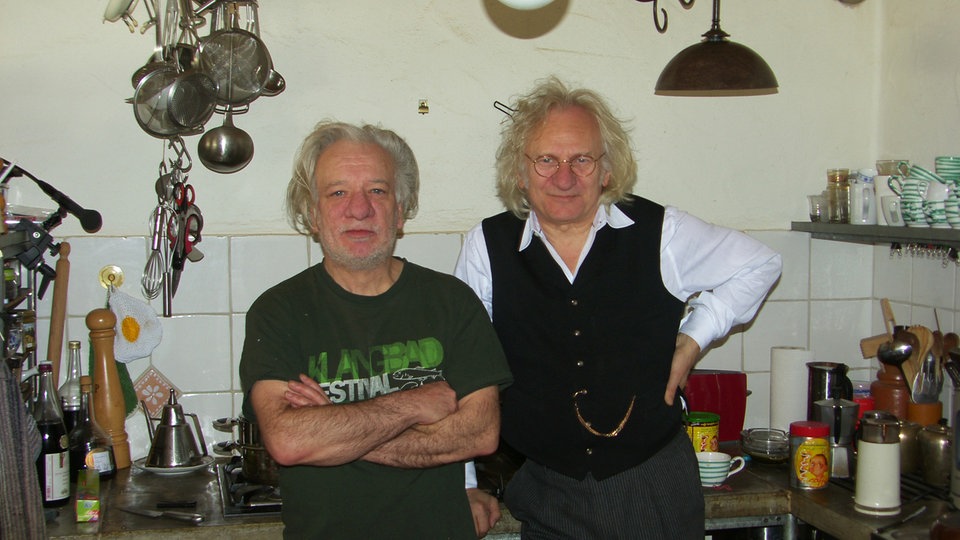
Musician and Sound Researcher FM-Einheit and Media Archaeologist Siegfried Zielinski in the sound laboratory kitchen. © picture alliance / empics
FM Einheit, sound researcher, composer and musician (formerly >Einstürzende Neubauten<), dissects, cuts, knocks, beats, stirs, plucks, rubs, scrapes, separates, connects. His kitchen in Tittmoning is transformed into a percussion stage and produces the chamber music of the preparation of a bone with a hole, which is called Osso Bucco in Milan. Siegfried Zielinski, media archaeologist, accompanies him with questions about (re)sources, the inspirations of cooking, the respectful treatment of food, the barbarism of industrial (ready-made) dishes that contain multiple kills, the poetry that a bouquet of basil can unfold, the immense difference between a mechanical mortar and an electric mixer. Production: WDR 2015/54’ Editor: Hannah Georgi
***
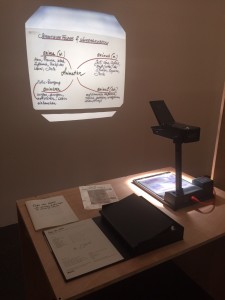
Photo: MRM 2014 Over the Head—Projecting Archaeology & Variantology of Arts & Media By Siegfried Zielinski / Edited by Marcel René Marburger Designed by Alexander Behn Limited edition: 111 copies Every book contains:
- 110 usable, carefully selected and reproduced transparencies from the archive of Siegfried Zielinski
- one original transparency from the archive of Siegfried Zielinski
- one booklet with an essay by Siegfried Zielinskiand an editorial by Marcel René Marburger (both English and German)
- every book is signed and numbered by Siegfried Zielinski
- every book is handmade by a Berlin based bookbinder
- Please order at info@edition23.de ISBN 9-783981-424614
***
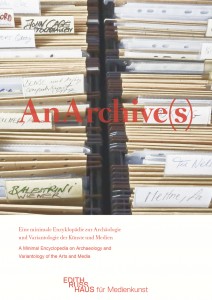
AnArchive(s) – A Minimal Encyclopaedia on
Archaeology and Variantology of the Arts and Media
Idea and concept: Siegfried Zielinski Text & copy editing by Eckhard Fürlus Edited by Claudia Giannetti Contributions by Hans Belting, Peter Blegvad, Hinderk M. Emrich, Wolfgang Ernst, Boris Groys, Erkki Huhtamo, Daniel Irrgang, MONO KROM, Friedrich Knilli, Peter Lilienthal, Anthony Moore, Solomon Nikritin, Nils Röller, Otto E. Rössler, Henning Schmidgen, Eugene Thacker, Amador Vega, Peter Weibel, Siegfried Zielinski to order at: http://www.edith-russ-haus.de/en/shop.html or: https://www.buchhandlung-walther-koenig.de
***

|
[... After the Media]: News from the Slow-Fading Twentieth Century by Siegfried Zielinski Paperback, 276 pages Letterpress Cover ISBN 9781937561161 Published first in 2013 Univocal Publishing at University of Minnesota Press |
The media are now redundant. In an overview of developments spanning the last seventy years, Siegfried Zielinski’s [... After the Media] discusses how the means of technology-based communication assumed a systemic character and how theory, art, and criticism were operative in this process. Media-explicit thinking is contrasted with media-implicit thought. Points of contact with an arts perspective include a reinterpretation of the artist Nam June Paik and an introduction to the work of Jake and Dinos Chapman. The essay ends with two appeals. In an outline of a precise philology of exact things, Zielinski suggests possibilities of how things could proceed after the media. With a Vademecum against psychopathia medialis in the form of a manifesto, the book advocates for a distinction to be made between online existence and offline being.
***
Further information
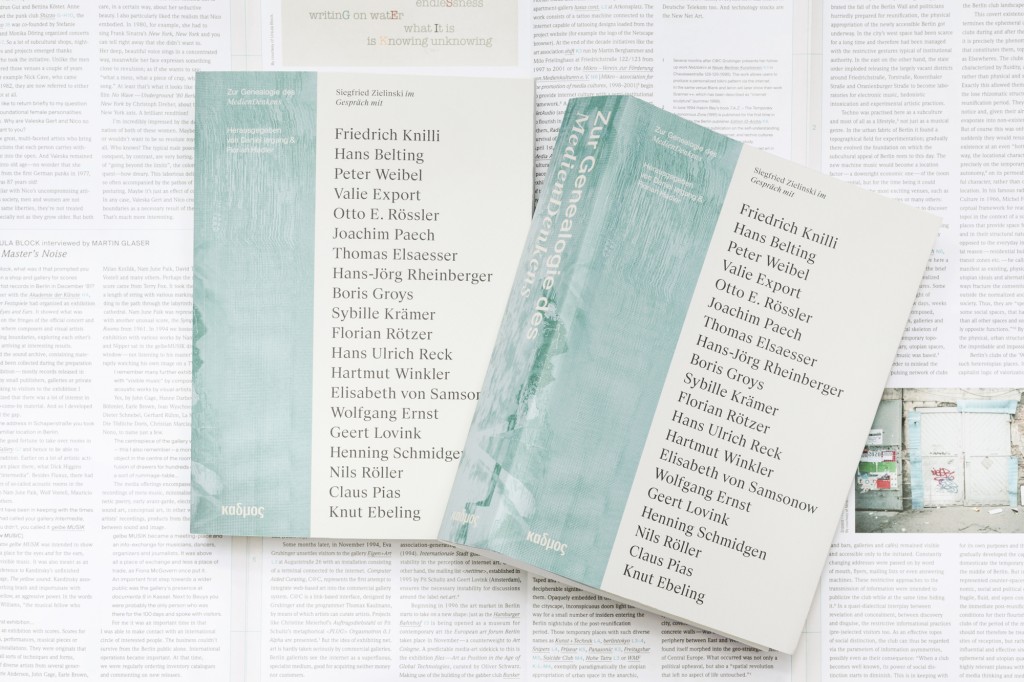
At Kulturverlag Kadmos: »Zur Genealogie des MedienDenkens«
–
A new, extended edition of our two volumes on MediaThinking was published by Kulturverlag Kadmos. It originates from Siegfried Zielinski’s conversations with his guests at the “Forum on the Genealogy of MediaThinking” panel series (2012 and 2014 at the Berlin University of the Arts) and is further extended with annotated contributions. The project attempts to grasp what has been developed in the last decades as “MediaThinking” in universities and various laboratories of today. The publication encompasses the two previous volumes released by UdK university press, supplemented with further conversations. Inserted is a large map, Atlas on Genealogy of Media Thinking in Berlin.
Edited by Florian Hadler and Daniel Irrgang.
–
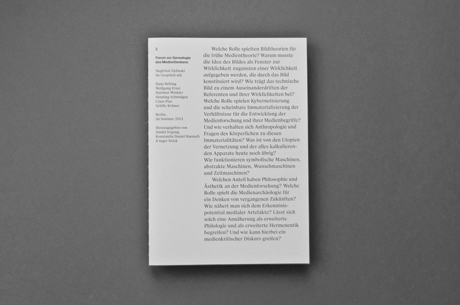
OUT NOW Volume 2 – Forum zur Genealogie des MedienDenkens
The second volume of the expanded documentation of the talks held within the Forum on the Genealogy of MediaThinking in summer term 2013 is now published by Verlag der Universität der Künste Berlin. Siegfried Zielinski in conversation with… Hans Belting, Wolfgang Ernst, Hartmut Winkler, Henning Schmidgen, Claus Pias and Sybille Krämer. It features contributions and material by Vilém Flusser, Florian Hadler, Konstantin Daniel Haensch, Toni Hildebrandt, Daniel Irrgang, Linnéa Meiners, Sandra Moskova, Inger Neick, Aneta Panek, Andreas Rauth, Sarah Johanna Theurer and Siegfried Zielinski. Edited by Daniel Irrgang, Konstantin Daniel Haensch & Inger Neick. The Forum on the Genealogy of MediaThinking – an essentially incomplete and open search for developments within the academic and artistic discourses about what media were, are and can be, drawn along the scientific biographies of Siegfried Zielinskis guests. It is an attempt to grasp in public talks, what has emerged as MediaThinking in universities and in the manifold current laboratories over the last decades. ISBN: 978-3-89462-260-2 The book is now available for sale at the UdK-library (foyer, Fasanenstraße 88, Berlin) for €15. It can also be ordered at Verlag der Universität der Künste Berlin (for an additional €2 shipping charges): Universität der Künste Berlin Universitätsbibliothek Publikationen Claudia Metz Einsteinufer 43–53 10587 Berlin Tel. (030) 3185-2157 Fax (030) 3185-2121 email publikat@udk-berlin.de 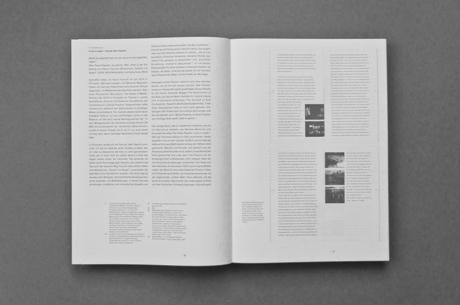
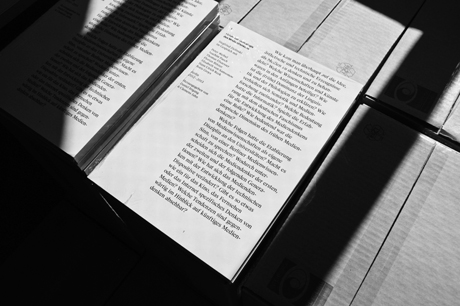
Volume 1 – Forum zur Genealogie des MedienDenkens
Siegfried Zielinski in conversation with… Peter Weibel, Joachim Paech, Thomas Elsaesser, Florian Rötzer, Elisabeth von Samsonow, Hans Ulrich Reck and Boris Groys. Edited by Daniel Irrgang & Clemens Jahn.ISBN: 978-3-89462-242-8The book is now available for sale at the UdK-library (foyer, Fasanenstraße 88, Berlin). The price is 15 Euro. It can also be ordered at Verlag der Universität der Künste Berlin (for an additional 2 € shipping charges):Universität der Künste Berlin Universitätsbibliothek Publikationen Claudia Metz Einsteinufer 43–53 10587 Berlin Tel. (030) 3185-2157 Fax (030) 3185-2121 E-Mail
publikat@udk-berlin.de

14.07.09 with Otto Rössler
Photo: © Thorben Stieler

14.07.02 with Geert Lovink
Photo: © Thorben Stieler
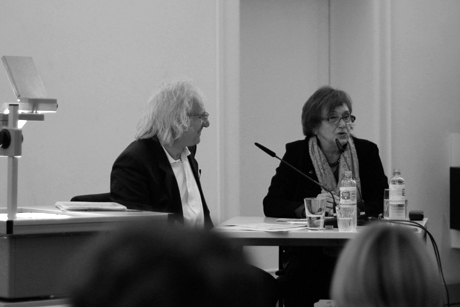
14.05.08 with VALIE EXPORT
Photo: © Thorben Stieler

15.01.14 with Knut Ebeling
Photo: © Thorben Stieler

18.12.13 with Nils Röller
Photo: © Thorben Stieler
Questions for Knut Ebeling 15.01.2014
I.
Knowing there is no way around it, i pose this rather inquisitive question right at the outset, not at least on behalf of my students: Your vita lists something that many might envy you for: 1993/94 – study of philosophy and aesthetics at Université Paris VIII. Michel Foucault and Felix Guattari had already been dead at that time. Gilles Deleuze died the year after your stay. May we ask you to give a short description of what these studies were like in Paris, twenty years ago? It occurs to me that the french master-thinkers of the past decades, who have in turn effectively influenced our thinking, conceive media rather in an implicit, as opposed to an explicit way (With the exception of the machine studies of Guattari and the explicit studies of cinema and painting by Deleuze). They are practitioners of what i call an implicit media thinking. In my understanding Knut Ebeling adopts this line of thought: his thinking of media is always an implicit, not necessarily an explicit one. Might that be beacuse it has long been unnecessary to specificly mention media in a philosophical or aesthetical context? Because media as explicit artifacts have long ceased to attract us? Or, to put it differently: In Knut Ebelings opinion – what are the lines of inquiry that still render direct mention of media or the media meaningful and interresting?
I.
Knut Ebeling did not make light work of his dissertation regarding his choice of subject. It still isn’t a matter of course within the media studies discourse to work in depth on the french poet-philosopher Georges Bataille (let alone on his obscene works). Within our german phylum of thinkers this has lastly and passionately been done by Dietmar Kamper, who has consequently complimented your dissertation, which contains the two readings about Batailles “Madame Edwarda”, as the philological masterpiece of a “bladerunner”, a highly venturous act on a knife’s edge. The scope of our work here at UdK Berlin doesn’t permit us to penetrate in depth the intellectual micro-universe of Bataille. But we can at least discuss some of the questions that are – as i perceive it – incorporated in your fantastic book: The two readings which you suggest for this formally pornographic text with the most famous ellipses of recent literature history do implicitly lay ground for the concept of the poet-philosopher, which is – at least for the highest plateaus of thinking – the idea of irresolvable unity of poetry and philosophy. Might such a plea be one of the cornerstones of your project? To say it with a stronger reference to the scope of our own work here: One cannot think philosophy anymore without it’s modes of mediation, without taking into consideration the modalities of how it is expressed or performed (it’s medial representation). In Batailles philosophic-theologic-aesthetic cosmos Edwardas trap stands for god in all exclusiveness. Is the touch of the whores labia through the lips of the first-person narrator, experienced as scandalous even in the public of the brothel, a fierce (and at the same time shallow) plea for the sensuality of the body as potential for aesthetic experience? (Similar to Bunuels/Dalis cut through the eye in “Un Chien Andalou” from 1928, or Simones incorporation of the priests eye in Batailles “story of the eye”, likewise from 1928) Can Bataille serve as vade mecum against an all too vain “self-certitude and security of the idea”, as it is still practised by scholasticism? A philosophy outside the realm of sensual experience, which would also mean: without media, through which it is articulated? To the contrary: Do you recommend to read the poet-philosopher as an aesthetic theorist, as a philosopher of aesthetics? Let us stay with Bataille for a short while to bridge from him to another large thematic field, in which you are working intensely. In one of your texts on archaeology you identify Bataille to be an early protagonist of an archaeological practise in it’s figurative sense. Could one interpret the project of the “Documents” magazine, which he developed alongside other authors, as an archaeology of the present in times of the late 20s economic crisis and just before the great catastrophies? (And, in terms of design, as an adventurous layout of horizontal connections of text and images, of different categories of text, that was doomed to fail 80 years ago, but has long congealed into a convention nowadays?)
II.
Without any doubt the archeological forms a vital dimension in Knut Ebelings media thinking. One might even say: For Knut Ebeling media studies is first and foremost a praxis within an “archaeology of the present” (in a benjaminian sense). The only difference being that his artifacts posess lesser distance to the “now”, than it was the case for Benjamin and his Arcades Project in relation to the 19th century (stadiums, iPhones etc.). Could one describe your intellectual approach as instant archaeology (the english term sounds a little better than the german “instantane Archaeologie”)? Perhaps it is better said from a spatial perspective: as an archaeology of proximity, of the things that approach our bodies? In the nice little book “Das Archiv brennt” (“the archive is burning”), which you have put together with Georges Didi-Hubermann, you state “not language is the home of being, the archive is the home of philosophy”, altering a famous phrase by Martin Heidegger. Like almost no other media theorist, Knut Ebeling has made efforts to sharpen the term of the “archive” in the context of the humanities and the arts over the course of the last few years, to work on the differentiation of its modes of usage, even to explicitly develop something like a critical archiveology. What is so fascinating to you personally about this “house” of contemporary philosophy? Do you link the archaeological method to a concrete hope “to find another access to the past” (a.a.O.:34), to pinpoint “escape routes from the prison that is history”, as you state in the first volume of “wild archaeologies” (“Wilde Archäologien”, p.732)? Or do you seek, in the sense of heideggerian formation of identity between origin and future, to develop open spaces for possible futures? Past and future as spaces of possibilities: “Archaeology and archives file the past, in order for it to befall us in the future”. (Wilde Archäologien / wild archaeologies, p. 731) And a few pages further into the book, even more to the point: “Because archaeologies mission is not the quest for old, but for new pasts and presents, it remained open – open for that project of ‘different archaeologies’ (Foucault), which are subject to Foucaults thinking towards the end of his archaeology of knowledge.” (p. 739) You keep stressing that archaeology as a discipline holds an important promise: to be able to couple natural sciences’ cool, and the humanities’ hot modes of thinking and methods. Does this contain the hope for an expanded hermeneutics? Or does it contain more of a long-term perspective of dissolution towards the objects of thought in natural science and their appliances, as it can be found in some of the less thorough readings of Friedrich Kittlers media theory? In the first volume of your “wild archaeologies” metaphoric disciplines like media archaeology are distinguished from the normal, tamed, classic archaeology by the fact that the former use the archaeological as a model for thinking, rather than as their program. The objects of a wild archaeology are not objects of utility, instead they are for instance the soul or the dream (as in Freud), the aesthetic sensitivities of the subject (Benjamin), knowledge (Foucault) or the media (as in Kittler). Thus, do the objects of a cultural- and media archaeological interest end up in the intermediate space between things of utility and things of thought, between metaphysics and physics…? And: would this be more of a precise or a soft ending? Your writings have helped me to better understand, amongst other things, one noticeable development. Not later than Michel Foucault “wild archaeologies” have turned into a possibility to practice materialism (in a narrow sense as the studies of “material culture”, see the WAs subtitle) without the dead weight of marxism or critical theory. Was it this development that rendered archaeology so attractive during the often hard-bitten battles in the late sixties and seventies? To finally be able to read Benjamin without the strait jacket of historical materialism? (sometimes elegantly achieved by Giorgio Agamben.) Here is an urgent question, that you possibly already discuss in the second volume of wild archaeologies: Given that the 20st century has been the age of diverse archaeologies, and thus has superseded the age of history (or better: historiography) – are there any speculations on the direction we are drifting in the 21st century? Do we fancy continuity again (put historiography for that) or can we take discontinuity to extremes any further?
III.
Unfortunately unavailable to a broader audience, yet accessible for privileged readers as myself – at least for me it was a surprise to see George Bataille appear as reviewer of the historian and anthropologist Huizinga and his cultural theory as game theory in Knut Ebelings work. “An archaeology of homo ludens” whom has already pervaded so called postmodern cultural philosophy (for instance very prominently in Vilém Flussers work): Where does this interest stem from and how did the indeed spectacular discovery of Huizingas manuscript come about, followed by its discussion mainly through Batailles and Caillois? With regards to this labyrinthic topic we have to pace ourselves and focus on a few thoughts. I want to highlight two aspects, that might possibly be related: First: the opposition between labour and play that was particularly brought up by Georges Bataille relating to his ostracized economics (as opposed to Huizingas seriousness and play / Ernst und Spiel). In your epilogue you say “common economics is that perspective, that does not view the game from the perspective of beneficial labour, but that views the benefit from a perspective of the game and of exhaustion”, and with this as an outset you denote a “common economics of the child”: “the games purpose is more than just purpose (Zweck) and exhaustion (Verausgabung), more than accounting” (12). Does your studying of early cultural sciences and philosophic game theory react to an everyday situation, in which labour and game, seriousness and game are interlocked to such a degree, that their differences are beyond recognition? In your text on “Spiel/Zeug” you discuss contemporary communicational gadgets as in this sense hybrid artifacts between labour and spare time, or rest (Lust- und Frustmaschinen)… “The game is cultures dream”, this is one of your lovely terms in the epilogue of the M & S book (p. 15). Shortly before that you have introduced the arts as a playfield affiliated to the game (“on lifes sunday, man starts to play, by making art…” p. 13) – Is it the denotational closenes of game, eroticism and the arts, that is so fascinating about this topic? “because the game is only real insofar as it is without purpose (interesselos), as it contains its purpose within itself.” (Huizinga: lecture version) This question you have also posed already: Do parts of cultural and media studies still (or once again) work theirselfes into the ground about the “paradoxon” to “integrate the phenomena of unproductive exhaustion (Verausgabung) into an necessarily productive and meaningful (sinnstiftend) cultural theory” (K.E.), as it is already indicated in Batailles model of a self exhausting poetic practise? (Or, as Bruno Schulz put it, facing Gombrowicz: It is about making even the last remaining unhumanized fields available for the project of humanism…) A book that Knut Ebeling has compiled and edited in association with Kai Schiemenz has as it’s focus a special locality of the game as spectacle. There, in what could be described as an “archaeology of organized publics” / spectacles as architectures, you analyse competitive sports arenas, “stadiums” by means of an “artistic-scientific spatial research”. Are these attractors of event-mediation the last instances of mass media, or are they already emergences of a culture after the media? Have the large and expensive arenas, for which the global players amongst architecture offices carry out proper fights, superseded the major hollywood studios?
IV.
As a closure: Amongst the scene of media thinkers Knut Ebeling is one of the few who decided to teach and research within an art academy. In your view, what are the benefits of intellectual practise in such a context?
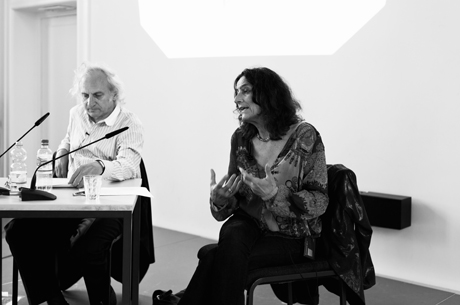
04.07.13 with Sybille Krämer
Photo: © Steve Bergmann
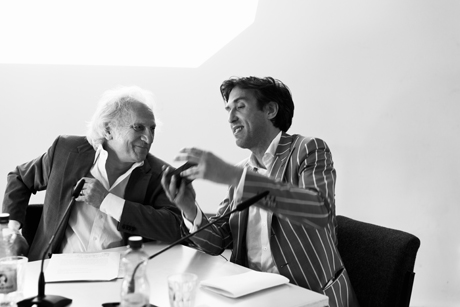
13.06.13 with Claus Pias
Photo: © Steve Bergmann

30.05.13 with Henning Schmidgen
Photo: © Robert Preusse
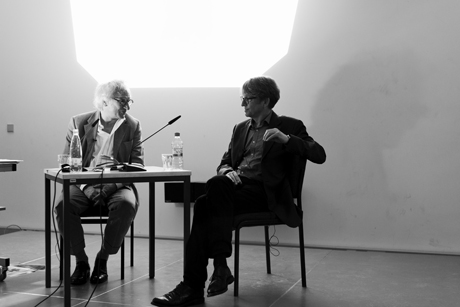
15.05.13 with Hartmut Winkler
Photo: © Steve Bergmann

02.05.13 with Wolfgang Ernst
Photo: © Leonard Jung

25.04.13 with Hans Belting
Photo: © Steve Bergmann
Questions for Sybille Krämer 04.07.2013
I.
Allow me to begin with an inquisitive and always urging question, which only philosophers can answer proficiently: throughout this series of panels we are deliberately working with an open operational concept of mediaThinking so that heterogenous media theoretical positions can have a say. During the previous century the most diverse concepts of media were invented and sharpened. Do we need one homogenous concept in your opinion, could such a concept even persist? Or is the coexistence and intertwining of competing concepts more appropriate for a field of research focussing on communications based upon or mediated through technology to be activated according to epistemological interests? Let us – along the lines of your work biography – proceed more systematically to the problems which drew (or dragged?) the philosopher Sybille Krämer into the discourse on the complex interrelations between culture, thought and technology. Is it possible for your doctorate thesis entitled Technik, Gesellschaft und Natur. Versuch über ihren Zusammenhang (1982, Technology, Society and Nature. Attempt on their relationship) to be interpreted as an attempt to develop a concept along the lines of a systematic social theory of technology? The leading perspective seems to be the derivation of technology from a “substantial mean-ends relationship” (“stofflichen Zweck-Mittel-Relation”), coming from a context of work and appropriation of nature. Besides epistemological issues knowledge from technical and industrial sociology and even engineering comes into effect at the same time. How could this rather odd mixture for a philosopher emerge at that time, which I would much rather associated with Günther Ropohl’s Systemtheorie der Technik (1979, System Theory of Technology), Werner Rammert’s sociological technology studies or Karin Hausen’s early accounts on the history of technology (e. g. The Social History of the Sewing Machine), whom I encountered during my studies at the Technical University of Berlin? Which were the references in philosophy for your early reflections on technology? Did the early cultural studies (Hoggart, Williams) play a significant role, with their discovery of the materiality of communications, or even the new psychoanalytically coined machine concepts from France? There is another less known yet more practical work related contextualisation for this field of research: from 1984 Sybille Krämer was part of the work group “Human beings and technology” (“Mensch und Technik”) as well as the commission “Artificial intelligence” at the Verein Deutscher Ingenieure (VDI, Society of German Engineers) in Düsseldorf. Which meaning did this cooperation have for the development of your specific concepts of technology (Technik und Technologie)? In 1988 your book entitled Symbolische Maschinen. Die Idee der Formalisierung in geschichtlichem Abriss (Symbolic machines. A historical abstract on the concept of formalisation) came out, to be followed three years later by your habilitation treatise Berechenbare Vernunft. Kalkül und Rationalismus im 17. Jahrhundert (1991, Computable reason. Calculation and rationalism in the 17th century). Heidegger still specified his understanding of technology along the lines of mechanical objects such as a hammer or a windmill. At the heart of your two books lies the insight that everything, which can be expressed through a law can eventually be mechanised, as Turing put it in the 1940s oder Mortimer Taube in the early 1960s – on the mediation part of formalisation, which e. g. can consist of an algorithm. Am I right in interpreting your books to be much less a contribution to the history of technology or aparatuses, but much more a contributions to the history of ideas of computation – and thus to that particular way of thinking, which precedes the computer as a concrete artefact and technological system in the very literal sense? What is epistemically concealed behind the idea to pay more attention to an activity (computation/formalisation) than to a piece of technology? Is it possible to read the Symbolic machines and the Computable reason from this perspective as fundamental contributions to the mediality of the computer, before the actual concept if the mediality in the context of your metaphysics has even been developed? In a legendary publication from 1989 on the archaeology of media, Norbert Bolz, at that time assistant in hermeneutics at the Institute for Philosophy at the FU (the time of Taubes and Hübener), writes his entrée into the media discourse with a discussion of McLuhan’s Understanding Media, which had been released a quarter of a century earlier. (Interestingly with paragraph-long quotations of the American text while a German translation had been around since 1968.) In the same book Dietmar Kamper writes one of his cultural anthropological provocations entitled: “Sturz der Bilder in die Zeit” (“Demise of the images into time”): “not from the margins, but from amidst the reach of power of modernity emerges a certain time machine, that swallows images, instead of revealing them any longer.” („Nicht vom Rande her, sondern inmitten des Machtbereichs der Moderne tauchte eine gewisse Zeit-Maschine auf, die Bilder verschluckt, statt sie weiterhin zum Vorschein zu bringen.“, Ibid., p. 143) – 1989: the year when Sybille Krämer takes up her professorship at the FU Berlin. How present were the traces of the third generation of German mediaThinkers at the philosophy department of the Free University at that time? What kind of intellectual and theoretical milieu did you encounter there, to challenge or advance your epistemological interest? Did your relationship to Wilhem Schmidt-Biggemann, Mr. Ars Combinatoria as we used to call him, turn out to be complementary? (Since at least with regards to the Early Modern Age your fields of research partially overlapped.)
II.
Which brings us to the second focus of my questioning: What are the intentions behind Sybille Krämer’s Metaphysics of Media (Metaphysik der Medien)? What is the concept aiming for? Which established discourses is the concept of the messenger or that of transmission trying to critically interfere with and what characterises its originality, not least in distinction from e. g. Michel Serres’ 1968 five volume anthropology of communications published in Paris named after Hermès, the messenger of the gods? Let us begin with the subject of critique to be found superficially in McLuhanism which has probably been identified much better throughout the media archaeology of Friedrich Kittler and some of his students. Against the technological a priori, shaping or even determining every medial process, Sybille Krämer focusses once again on that which processes in-between the medial and on how mediation takes place as transformation (Übertragung). Would you agree with this description of the tensions unfolding in your book from 2008? The point where spirits in media theory significantly part is nothing less but the concept of media itself. In your 1998 contribution to Media, computer, reality (Medien, Computer, Realität) you clearly put your concept on the table: “We do not hear vibrations of air but the sound of a bell, we do not read letters but a story […]“. The medium tends to be invisible/inaudible. Only through noise or a film tear it obtains validity. What is the epistemological core of the concept of a “transparent medium”? What is the concept of an immediately experienced mediacy (2008, p. 103) useful for? Another question imposing itself on us in the context of our work together with the arts: which kinds of medial processes does your theory focus on? Ideal every-day communications, that are technologically mediated (which used to be called mass media)? Since the first European avantgarde about 100 years ago, artists have been deliberately working with the anti-Aristotelian concept of inextricably linking the medium and the message with each other making and keeping the medialised world, being a technologically produced world, experienceable beyond strategies and tactics of the destruction of the material. Which has been adapted throughout TV shows, interface design and advertising. What is the use of the construction of a medium which one principally does not recognise, which allows frictionless immersion? Your heuristics of the messenger, whom the message is not (yet) separated from, keeps insisting on the messenger’s corporeality (Körperlichkeit) (the absence of which you regret throughout Kittler’s writing despite his pleas of physical hardware). It has been attempted several times to write the genealogy of telematic media as a process of the successful separation of the message from the body of the messenger. Does Sybille Krämer’s metaphysics put something back into play which seems to have already evaporated under the condition of electronic and digital communications? What is the meaning of your peculiar concept of the trace in this context (as opposed to the symbolic “conventionalised sign”)? Does it contain an offer for perception (aisthesis) within the medial process? “With mediality“, as you put it in your little metaphysics, “we do not mean distinguishable media such as sound, text, image, but a description and line of interpretation of our human form of life and culturally shaped world which aims for an elementary dimension.” (2008, p. 103, „Mit Medialität meinen wir nicht voneinander abgrenzbare Medien wie etwa Ton, Text, Bild, sondern eine auf eine elementare Dimension zielende Beschreibungs- und Deutungsperspektive unserer menschlichen Lebensform und kulturell geprägten Welt.“) Does this imply a return to anthropological problems? Some of the texts connected with this idea were published in Paragrana, the in-house periodical of the department for Historical Anthropology at the Freie Universität Berlin- Is your research on the voice and its floating existence “between reason and power, between seduction and concept” (Negative Semiologie der Stimme, 2003, p. 77, „zwischen Ratio und Macht, zwischen Verführung und Begriff“) to be read along the same trajectory? Here, too, your focus seems to lie on that which articulates itself in speech act beyond that, which can be ordered according to symbolic rules and which permeates through the mask of the person (per-sonare) in the tension between the Dionysian and the Apollonian…
III.
Piercing the heart of the human being/machine relationship, especially within a design and art context, a distinction can be found throughout your writing since at least 15 years: between the instrument (as mediator for a particular use) and medium (as mediator of something). Technology as a tool follows a clear function, it saves work; whereas technology as an apparatus should be understood as a machine generating world – is how one could attempt to reconstruct correspondingly from your texts from the 1990s. Does this distinction between instrumental and medial use account for the “trans-classic machine” (Bense) as well, the “abstract machine” (Chomsky)? Or has the tool-medium dualism invaded the inner life of telematically networked computers, unfolding as a normal tension in various dimensions? “The branch of mathematics, which uses diagrams, isn’t called formal but intuitive, or at least is attributed certain intuitive elements”, Mortimer Taube accounts in his legendary text on the Myth of Thinking Machines from 1961 (quoted and translated from the German edition, 1966, p.13, „Den Zweig der Mathematik, der Diagramme verwendet, bezeichnet man nicht als formal, sondern als intuitiv, oder man schreibt ihm zumindest gewisse intui-tive Elemente zu“). The diagrammatic, which you have been concerning yourself with throughout the last years, seems to be located between the tool (for thinking) and your concept of mediality, which generates, leaves and transfers traces. That, which you call “operative imagery” (“operative Bildlichkeit”) deals on one hand with those schematic “mediators between thing and concept, the particular and the general” (“Mittler zwischen Ding und Begriff, Einzelheit und Allgemeinheit “), as has been thought and done with diagrams in ancient cultures. On the other hand, Sybille Krämer aims to rediscover and to reactivate the schematism and the scheme, the monogram respectively, in Kant’s Critique of pure reason and of Judgement. “…schematism is a procedure of imagination” („Logik des Bildlichen“, 2009, 109, “[…] der Schematismus ist ein Verfahren der Einbildungskraft“). The “figurative Synthesis”, which can be expressed through schemes, obviously has special importance to you as an activity? What is so special about this kind of imagination which can be transformed from a synthetisation of the manifold (past) into a schematisation of the future possible? How close is this conception of imagination, which can be articulated diagrammatically amongst others, to Kantian philosophy and how distant is it from Heidegger’s metaphysics-critique of Kant? Two questions in the end, which have been discussed earlier in the seminar: John Durham Peters’ deep time study of communications plays a surprisingly fundamental role in the development of your Metaphysics of mediality (Metaphysik der Medialität). He is one of the few intellectuals, who does not automatically apply a halo of the emancipatory to communications. What is it that fascinates you about this concept, which might have been put most pointedly in Guy Debord’s art loving philosophy: telecommunication connects, but it can only connect that which has already been disconnected. My final question is referring to the so called “speculative realists”, who interestingly claim to develop a new metaphysics, too. We travelled through Brazil with one of them. Graham Harman also refers to McLuhan critically insinuating that he (just like Heidegger) did not attribute any meaning to the content of a medium, opposite to its “deep and invisible ground”. (A hypothesis which I personally find very questionable.) From a media philosophy allegedly adverted to contents he deducts his plea for a return to a phenomenology of the real, for an attention to the material or, as Vilém Flusser would have put it: to an appraisal of the superficial. Are these challenges at all for a contemporary German philosopher, who is interested in mediality?
Questions for Claus Pias 16.06.13
Brief recapitulations usually carry the risk that interesting and resistive details as well as distinctive particularities could get lost on the way. At the same time I will try to begin with a résumé of Claus Pias’ supremely multifaceted work both in research and teaching by focussing of on a subject matter brought forward with an inquiring gesture: Does you peculiar Archaeology of the Present revolve around the tension-filled relationship between open and closed systems, between deterministic relations on one hand and casualness or even arbitrariness on the other?How could we try to define this question more precisely? Two of Claus Pias’ outstanding research foci lie on the manifold aspects of cybernetics and that version of games, which is constituted and processed through progressive technology, especially the computer. Taking a closer look at these two trajectories, a clear focus becomes visible between or through the connection of the two: How much of a scope does technical thinking and acting within sets of rules with a high degree of order allow, and what are the regulations (programs), which not only make it possible but vital to play?One of your theoretical positings when dealing with both, cybernetics and play with and through the computer, is the production or better: the opening of a “common space of meta-technology” (eines “gemeinsamen Raums der Metatechnik”), emerging on the margin between man and machine and at the same time during the process of perambulating this margin. Does this mean an ultimate rejection of the anthropological issues which were characteristic for the 1980s (Kamper, Wetzel etc.) and are massively returning in other fields these days? Or putting it more positively: Does the “common space of meta-technology” represent a shift away from the original bifurcation towards a new possible union between bios and logos of expanded life and thought?How does such an imagination of compatibility essentially differ from that, which Gilbert Simondon conceived in 1958, by calling the machine a “stranger” incorporating “the human” (which also contains the reversed thought, namely the human incorporating the mechanical)? Or even from much earlier concepts of interdependent relationships between nature and technology, e. g. in the Early Modern Age or during the Enlightenment?Following your peculiar accentuation of the relationship between (Media)Men and (Media)Machines as a non trivial relationship, obviously the imaginary union can impossibly be imagined as a return to paradise. At the end of your text on “Cybernetic Utopia” (“Die kybernetische Utopie”) you unmistakably point out that the “politics of intervention” (“Interventionspolitik”) of the production of a permanent equilibrium, of an encompassing Homeostat, can only be a “utopia of the end of utopias” (“Utopie vom Ende der Utopien”). Can we reliably speak about the end of something, which is characterised by its purely imaginary existence? Or what is this polemic aiming at?In many passages of your accounts on the playful explorations of complex realities the concept of “equiprobability” (“Gleichmöglichkeit”), of “equiprobable realities” (“gleichmöglichen Wirklichkeiten”) keeps reappearing. What is the story behind it? Is this about a constellation of a constant horizontality of events in a universe of the immaterial?The character of the hacker, who has grown so dear to many of us, is being depicted by Claus Pias along a trajectory of ambivalent appearance “in between subversion and underpinning the state”. Despite (or because of?) simultaneously being “weapon and shield” he is being “apostrophised as the new leading figure for the intellectual” beyond the shopworn “social utopias”, which were yet holding true for the proponents of interventional justice, such as Brecht or Enzensberger. How are we supposed to imagine the social plane onto which the new guiding light is being projected (or out of which it has been generated)? What are the features of this present, which Claus Pias is ploughing through with his archaeology? What defines this present? Is it the “aesthetic state based upon turing machines”, as you put it towards the end of your text on the hacker?Hasn’t especially Baudrillard’s now twenty years old instruction turned out to be a fatal strategy or at least a precarious tactics, claiming that an interfering thinking and acting in an age of infinite simulation and immaterial modelling could only come into effect through the symbolic?Considering our small genealogy of mediaThinking we are especially interested in finding out more about the initiations, motivations and impulses, which each individual mind has helped to bring forth, develop, irritate or sharpen. These origins of thought differ greatly with every single scientist or artist. Claus Pias is neither a Heideggerian nor a Husserlian, neither does he splice with Lacan’s psychoanalytical fabric, nor with Guattaris desire machines or the latest ontologies of French and Italian provenance… Did I make a false observation when claiming that your writing makes do with very few references to meta-theories, world views, philosophical legitimations and speculations?If my observation is right, however, how is this phenomenon to be interpreted? Does this express the virtue of the media theorist starting his career at a time, when media science was already established as an academic discipline, legitimately sufficing itself?Or – with an explicit reference to your paper on the bygone present of media studies: Why do you think was it impossible for media scientists to come up with such a thing as media sciences?Following your notion in “The Epistemology of Computer Simulation” (“Epistemologie der Computersimulation”, 2011) of media studies being less of a “discipline” but a peculiar form of inquiry throughout research, wouldn’t we then have to be consistent and dissolve the established subjects and courses once again in order to let the anarchic and disturbing potentials of mediaThinking unfold in other environments?Characterising the strategic think tanks in your text on (Super)Herman Kahn, you speak of a “poetic imagination”, which enters “an odd mixture with a superordinate rhetorics of facticity in numbers, statistics and diagrams”. Is this the facultas imaginandi, the “new force of imagination” (“neue Einbildungskraft”) which, e. g. Flusser kept enthusing about? From the abstract into the concrete? Is your perspective in this context a purely retrospective one, or are you actually perfectly depicting the educational ideal of contemporary academic institutions between the training of computational skills on one hand and a sensitivity for aesthetics on the other?What seems noticeable for someone so centrally dealing with computers and their telematic interconnectedness: Why do linguistics, semiotics, the meta-method of structuralism, which strongly influenced our socialisation at the TU Berlin play no significant role in your reconstruction of an early thinking of media in the Federal Republic of Germany? The comprehension of de Saussure as much as Wittgenstein’s language philosophy, but also Karl Bühler’s language theory, which played an essential part in outlining the argument of Hartmut Winkler’s “Docuverse”, was at least as important as experimental poetry, the theory of the total play of sound or an experimental radio or better: acoustic culture developed with magnetic tapes and the new electronic possibilities. The experiments Ballestrini and Eco began to extract from computers as poetry – beginning in 1961 – were not as familiar to us, as Oswald Wiener’s explorations on the improvement of central Europe with the bio-adapter attached (1969), which at the same time provides an impressive interface theory…I very well remember hearing and seeing the first lectures by Claus Pias in the last century in different places. What impressed me in particular was the connection of a concise technological expertise – which is rare in media studies – paired with remarkable sensitivity for aesthetic expression. In 2004 – parallel to your research on computer games and cybernetics – you published a little book on the flamboyant painter and artist Anna Opperman. What meaning lies in painted, drawn or photographed surfaces for you, or in brief: what meaning do artistic depictions have for Claus Pias today?Putting the question more strongly in the context of our discussion: where would you say are intriguing points of contact between genuinely artistic and genuinely scientific questioning to be found today? Or doesn’t this distinction make any more sense? Does everything dissolve in the collective effort of conceiving the world creatively, to be executed with the respective only gradually differing means?After all, one meta-relation at the end, which is much more located in the field of media itself: in Claus Pias’ more recent texts strong references to Bruno Latour’s Actor-Network Theory are to be found, who currently fulfils a function within the intellectual landscape similar to that of McLuhen half a century ago, who you also keep referring to rather praisingly. Allow me the provocative question: Where does you fascination for these undoubtably elegant and equally eloquent pop-stars of contemporary technical thinking (Technikdenken) with obvious Catholic intentions stem from (with both having digested like mother’s milk what Latour calls “virtual Catholicism”)?
Questions for Henning Schmidgen 30.05.13
With respect to the development of a mediaThinking we are impudently curious about deciding events / encounters in each of our guests’ individual biography, which in the case of Henning Schmidgen appears to not have proceeded quite linearly. How did those connections emerge between studying psychology and philosophy at the Freie Universität Berlin (which was built upon humanistic foundations) on one hand and the history of natural sciences and technology as well as your studies of psycho-analysis and psycho-analytically influenced philosophy on the other (which was the reason for which you went to Paris)?Asking more systematically: How do we have to imagine the psychologically trained mind, concerned with communication in between the various energies and fields of intellectual work, entering the materiality of the exchange processes between men and machines respectively in between machines? Is this about generating certain interrelationships or is it more about developing an extensive “giving meaning” (Sinngebung) to the world as one single gigantic experimental system (as, amongst others, suggested by Bruno Latour)?How did your curiosity about technology turn from What into How, so to speak from ontology into something one may call a modal phenomenology?But let us first talk about your book on the Unconscious of the Machines (Das Unbewusste der Maschinen). What was – and is – the higher goal of this text, besides the already eminent gift to facilitate access to the rather maze-like and manifold thinking of Deleuze / Guattari via Lacan on and through machines? Is it about conceiving a mirror reality of that which already resonates in the title? Is it about the appliance of the unconscious, for which there are numerous elaborate variants in Anti-Oedipus which Guattari summarises as the “machinic unconscious”?Guattari and Deleuze (who were put by you in this same order – despite the fact that these authors’ names usually appear the other way around; because you think Guattari plays a greater role for machineThinking?) did not participate in the stabilising of a convenient thinking in dualisms: psychology / technology, machine / human being, organism / mechanism… You describe their thinking more as an attempt to address that which disconnects and reconnects the poles, “the connective, transversal, subjectively-objective” (168, “das Konnektive, Transversale, Subjectiv-Objektive”). (Deleuze did the same for Jean-Luc Godard’s filmic works.) Could this possibly explain that both Anti-Oedipus and 1000 Plateaus were often exploited for their delightful buzzwords and as a source for metaphors, but hardly ever used in the formation of media theoretical concepts?Throughout the reception of post-war structuralism and later post-structuralism the technology and machine concepts of Guattari / Deleuze and Lacan are usually being named in one sentence. In your book, however, you impressively prove that not only the two volumes on capitalism and schizophrenia can be read as a critique of the rather static Lacanian concept of technology, but even more that there are significant differences between the two authors, Guattai and Deleuze. (Which – as depicted by you in another passage – eventually led to the replacement of the machine with the much more vague “Agencement”.) – Could you be bothered to point out the most important differences concerning the machine concepts of the by now famous French intellectual triple once again for us?The need for science and technology to legitimise, politically or ethically justify, sell and administrate themselves, has become a low pun throughout the critical and therefore historical discourses. (The consciousness of it, however, is not very old.) During your research on the scientific experiments conducted to explore both the psyche and the material world, you have been – in collaboration with Hans-Jörg Rheinberger and others – closing in on a certain taboo. Namely, the positing of the scientific experiment as some sort of objective empirical continuous-flow water heater to generate factological scientific data. Put media-theoretically: the channels through which knowledge is being generated are as neutral as the scientific judgement itself. Are you aware of how much you have contributed to a change in media theoretical thinking during the last fifteen years?And what about the transformation of our concept of media aesthetics? Perception becomes a crucial factor when asking what disturbances an experiment (an act of communication) is influenced by, what noise and other oscillations co-write and generate data during micro time measurements, how noise is able to fundamentally influence the outcome of psychological laboratories… these are all questions, which co-determine the culture of the experiment. At the same time these are questions to be asked in relation to the contextualisation of perception in other fields of thinking and acting, especially when they deal with apparatuses…More than ten years ago at a congress on “experimental arcades” you held a lecture on the “sound and speed of thought”, where you talked about ears, words, the recording of language, membranes and tuning forks. How important are sound and the recording of sound for your current research?Time and in particular its micro-structures, its (attempts of) measurement occupy a very important place in your research. Your habilitation treatise was on the Brain and Time. The history of an experiment, 1800–1950 (Hirn und Zeit. Die Geschichte eines Experiments, 1800–1950) and will be published this fall by Matthes & Seitz. How did such a close entanglement between exploring the psyche and time emerge, of these two great unknowns of our being there (Dasein)? What exactly is the 150 years experiment at the centre of your investigation?”…the history of time is in itself a history of machines”, says Henning Schmidgen, referring to Lewis Mumford’s famous verdict of the clock as the master or “key machine” in the modern age. And he concludes with calling Deleuze / Guattari’s concept of the time machine a “theory of the experiment” (Variantology 1, p. 156). This would turn the books on capitalism and schizophrenia into the greatest tool boxes for psychologists interested in natural sciences? Is this were experimental psychology and a culture of the experiment focussing on time come full circle?One thing which electrifies us Variantologists: in the introduction to the magnificent encyclopaedia for Hans-Jörg Rheinberger you demand a natural history and a history of science to be “extrapolated through speaking and thinking in the mode of the bygone future” (“Sprechen und Denken im Modus der vergangenen Zukunft erschlossen werden”). Every single event within the museum space as well as every scientific development forces us to “revise history and its categories” (“die Geschichte und ihre Kategorien zu revidieren”). And you finish this passage with an interesting provocation: “At this point the historical itself becomes experimental. Going to the museum becomes similar to going into the laboratory” (“An diesem Punkt wird das Historische selbst experimentell. Der Gang ins Museum ähnelt einem Gang ins Labor”). Could you possibly expand on this conclusion? Does history itself turn into a potential space at this point?Do we then live in a time machine?”Bruno Latour is creating a furor” (“Bruno Latour macht Furore”), says Henning Schmidgen on the back of his Latour monograph published by Junius. Which is – as far as I know your work – not the main reason for the intensity with which you have been concerning yourself with him, leading to your dedicating 200 pages to him. With his change of paradigm “from ‘matters of fact’ to ‘states of affairs’” he already initialised the project of a culture in the experiment. What would you say lies at the heart of your fascination with this “border crosser between natural sciences and humanities” (“Grenzgänger zwischen Natur- und Geisteswissenschaften”)? The way he thinks the history of science through the history of the experiment? His Actor-Network Theory? Probably not so much his recently insinuating tendency towards questions of aesthetics on one hand, throughout a more and more obvious search for harmonising transcendental qualities or experiences within the pluralism of heterogenous ways of being?In your short text entitled “The meaningful silence of appliances” (“Die vielsagende Stummheit der Geräte”) you emphasise, that Bruno Latour is much less interested in appliances themselves, but much more in their “role as mediators and translators” (“Rolle als Vermittler und Übersetzer”), which means, their medial functions par excellence. (Which is what Latour shares with Heidegger, by the way, whose concept of technology you well pointedly put into proper light, rhetorically resorting to Günther Anders.) Might this be a reason for how fascinated many contemporary media scientists are by Bruno Latour? (“No transport without transportation”, Transmissions are always transformations at the same time etc.?)As an interesting alternative to dealing with things as things (as oppose to considering them “inscriptions” ["Einschreibungen"] for something else)in this text you recommend text a “more intense dialog with the museum-based instrument studies” (“intensiveren Dialog mit den museumsbasierten instrument studies”, p. 44) What are we supposed to imagine behind this new direction of research? Does a new hermeneutics expanded on machines and appliances lie hidden behind it, capable of saving its objects, repairing, reconstructing and actualising them? (See e. g. David Link’s “Love letters” project for documenta 13 or Wolfgang Ernst’s media archaeological fundus of time critical media.)Today Gilbert Simondon is know for his peculiarly close relationship to the perceptible surface of technical objects and systems. In a review of the German version of his techno-philosophical main work you wrote: “Simondon is putting the Heideggerian proposition that ‘technology is itself nothing technological’ upside down. Heidegger was satisfied at his time to discover a lonely timber mill during one of his Black Forest hikes, in order to lead techno-philosophical reflections into great depths. In contrast Simondon through and through acts as an urban philosopher who lives amidst technology. As soon as we are dealing with the “question concerning technology” he opens his tool bag in order to unscrew a TV or telephone set or to dissemble a two-wheeler engine.” (“Den Heideggerschen Satz, dass das Wesen der Technik ‚ganz und gar nichts Technisches’ sei, stellt Simondon vom Kopf auf die Füße. Heidegger hatte es seinerzeit genügt, auf einer seiner Schwarzwaldwanderungen eine einsame Sägemühle erspäht zu haben, um die technikphilosophische Reflexion in große Tiefen zu führen. Simondon agiert dagegen als durch und durch urbaner Philosoph, der inmitten von Technik lebt. Sobald es um die ‚Frage nach der Technik’ geht, öffnet er seine Werkzeugtasche – um einen Fernseh- oder Telefonapparat aufzuschrauben oder einen Zweiradmotor auseinanderzunehmen.”) Which are the most important impulses Simondon has to offer for a contemporary way of thinking (media) technology? (The ensemble, technological and human individuals / ANT, the becoming of artefacts and technical systems of affairs…)In an age of rapid and exuberant availability of indexical information, where does your distinct interest in encyclopaedias, dictionaries, indices stem from… (Bataille’s critical dictionary which he had developed as an appendix to his Documents, the encyclopaedia for a life science of the 21st century, the virtual encyclopaedia of experimental sciences on the internet)? Where is the difference between the classical encyclopaedia and Henning Schmidgen’s concept of it? (A logics of the manifold / heterogenous versus the creation of a homogenous body of knowledge?)Asking more generally: What lies at the heart of your curiosity about the bulky work of Georges Bataille? If at all, the other history of the eye is being mentioned in media theory, especially because Roland Barthes wrote about it. But what about the ABBÉ C’, THE INNER EXPERIENCE or similar texts? Knut Ebeling is one of the few who are currently working with these texts. The last person who vigorously put these texts into play was Dietmar Kamper, and he died twelve years ago…When mass use of networked computers began, Pierre Lévy would rhapsodise about his hope that cultural techniques such as digital hypertext would try to “break down he ontological iron curtain between being and things” as Félix Guattari put it in one of the Merve books you edited. Similar to the auto-poetic, the “and ‘hypertextual’ position of the machine thus possesses a pragmatic potential, which allows for a creative standpoint of machinic composition, occurring in the face of the ontological iron curtain which separates the subject on the one side from things on the other.” – Is this an indication of Guattari’s unfinished project to re-think the machinist in the light of new developments? (See e. g. the “machine of subjectification”, Guattari, On Machines)How does this concept, this projection differ from what Henning Schmidgen himself puts at the end of his book on the Unconscious of the machines (Das Unbewusste der Maschinen)? “The image of a progressive submission of human beings under the machine shall be opposed from the perspective of the Anti-Œdipe with the imagination of an extensive bricolage: the social characters of the ‘obsessive-compulsive programmer’ or the ‘mechanical character’ are being confronted with the tinkerer who continuously assembles and dissembles his own open and flexible machines with simple and limited means, so that in the end there is no more difference between producing and the product.” (“Die Sozialcharaktere des ‚zwanghaften Programmierers‘ oder des ‚maschinellen Charakters‘ werden mit einem Typus des Bastlers konfrontiert, der mit einfachen und begrenzten Mitteln fortwährend seine eigenen offenen und flexiblen Maschinen zusammenbaut und wieder auseinander nimmt, so dass schließlich kein Unterschied mehr besteht zwischen Produzieren und Produkt.” [Das Unbewusste der Maschinen, p. 167])Following Simondon: does this mean a dissolution of the difference between the engineer and the tinkerer?
Questions for Hartmut Winkler 16.05.13
Your first course of studies was an architecture program and your first professional activity was in the field of applied urbanistics. Which is quite uncommon amongst mediaThinkers. Although there was an early architectural semiotics and the theoretical investigation of technical media had become part of architects’ every-day practice, it stayed widely unnoticed in the media science scene of the 1970s… What role did architecture play with all its ramifications for the development of your concepts of media?In your 1990s writing about the inner structures of telematic networks, such as search engines, images and metaphors recur with spacial character – or ones that are related to n-dimensional realities of life (e.g. ars combinatoria, the Theater of Memory). How deeply was your imagination of media phenomena influenced by an architectural intellectual experience? is my observation correct, that during the last decades (between ca. 1975 and 2005) within your own Diskursökonomie (Discourse Economy), a system of quasi-spacial constellations, has more and more been replaced with the hegemony of a system of language?Even though Berliners usually don’t like to here this: in the 1950s Darmstadt – the place where you studied – was already a hot spot for experimental art. Especially for the protagonists of experimental music, fluxus and performance art, who equally worked with the media machines from that time. (The International Institute for Music Darmstadt (IMD) emerged from the international summer school programs which started as early as 1964. John Cage, Nam June Paik and many others were part of it.) Since 1970 the group Telewissen (Tele-knowledge) was active, which was run by Herbert Schuhmacher… Were you in touch with this scene during your studies? Were you interested in these early media and action arts?Almost cherished like a myth in German media science: Hartmut Winkler belongs to the few who not only wrote about computers on a meta-level. After your first university course you began to work for a communal datacenter in Darmstadt as a system consultant for urbanistic decision making and processes. One of your texts, which can be downloaded on our website, Strange Attraction 1975 deals with the existential encounter with data processing systems, their programs and their sound. Can we possibly reconstruct retrospectively how these two processes developed in your head – next to each other? Or intertwined with each other? –, namely: thinking through media and thinking about media.In your pointedly critical discourses on German positions in media theory I find it conspicuous, that especially those individuals come up short, who are quite rightly named the typical meta-thinkers / high flyers of medial technologies (e.g. Norbert Bolz). As opposed to those who actually concerned themselves with machines (e.g. Kittler): they are being praised by you. Of all great mediaThinkers of the 20th century, Vilém Flusser is particularly important to you. Which we of course appreciate. Usually people from the scene steal from him, without referencing to him. Books such as Does writing have a future?, Into the Universe of Technical Images… are important points of reference for Hartmut Winkler. In Flusser’s cultural anthropology a new “imagination” plays a meaningful role, which he connects with networked calculation and programming. What force / energy did this imagination have for your own work and still has today?At the beginning of your publicly recognised scientific career as a media theorist, however, were all those pieces of media which essentially were still shaping the popular discourse during the 1970s and 80s: television and cinema. Did German studies (linguistics or rather philology) provide the energies for you to devote yourself to the so called mass media? How did this movement away from architecture towards the audio-visual techno-theatres and discourses emerge?In your first books you focussed on ways of perceiving and using media technology. Switching / Zapping dealt with a new type of sovereignty which a conscious use of the remote control enabled, opposite to the remotely controlled flow of broadcasting: “Absent-mindedly, sceptically and dreamily the recipient pushes his buttons and amidst the haze of images the vision of the »talking heads’« benevolent chatter dissolves on once again reassembling the world.” („Zerstreut, skeptisch und träumerisch drückt der Rezipient seine Tasten und im Bildernebel zergeht die Vorstellung, das gutwillige Gerede der ‘talking heads’ könne die Welt noch einmal zusammensetzen.“ Here from Zapping, Ein Verfahren gegen den Kontext, 1990) Der filmische Raum und der Zuschauer (The Cinematic Space and the Spectator) liberates itself and us – with the help of French apparatus-heuristics – from the illusion of cinema / media technology being a “semantically neutral means (here quoted from: Der Zuschauer und die filmische Technik, in Filmwahrnehmung, Dokumentation der GFF-Tagung 1989, ed. by Knut Hickethier and Hartmut Winkler [Berlin 1990, 25]) How important is this perspective of the user – the active media(Wo)Man dealing with the mediaMachine – to you?Is the sovereign user, who understands technology and who is in control of it, a guiding principle for the exploration of the computer as a medium? And of networked computers, which you addressed with all their hierarchies and prerogatives of interpretation as progressed computer politics? (E.g. your critique of the early “search engines” for the www, Telepolis, 1997)The term Docuverse, which is the title of your habilitation dissertation, was coined by the founder of the republic of Xanadu, Ted Nelson. Formulated rather pointedly he uses the term to name the paradise of a strictly rationally and at the same time highly complexly networked semantic and syntactic structure, which in 1997 when your book was published, was still called hypertext. What influence did Nelson’s techno-utopian thinking have on the development of your concept of media? Do you still you the concept of hypertext in you teaching?Your text on (“Suchmaschinen”, Telepolis, 1997) ends with an impressive yet disconcerting image: “We are sitting on the abandoned throne of God, across from us the infinite universes of text, in our hands a few glittering yet deficient machines. We feel uneasy.” (“Wir sitzen auf dem verwaisten Thron Gottes, uns gegenüber die unendlichen Textuniversen und in der Hand ein paar glitzernde aber defizitäre Maschinen. Und uns ist unbehaglich.”) What would you like to add to this in 2013?The metaphor of an “externalisation of language” (“Externalisierung der Sprache”), through which the new “computer-universe” (“Rechneruniversum”, Docuverse, 17) may be expressed, reminds us of one of the central paradigms of the first pop-star of media theory, to which many of the authors critically discussed by you in Docuverse reference to: Marshall McLuhan. How important was his idea of a telematic network as an externalisation of the human central nervous system for your concept of a semantic and syntactic structure manifested in a network of hardware entangled with software, equivalent to human language? Why do you distance yourself this harshly from the Canadian author, leading to a proposal hardly to be realised, to think your externalisation in brackets? (Docuverse, 52–53)In your plea to interpret media at the end of the 20th century as a networked language structure, the founder of structuralism Ferdinand de Saussure and some of the adaptations of his ideas through French post-war intellectuals, especially Lacan and Derrida, are naturally playing a big role. Knowing the development of film and cinematic studies as an early media science, you are aware of the fact that the first ca. 10–15 years (late 50s until early 70s, including apparatus heuristics) were essentially spent projecting knowledge from linguistic structuralism onto phenomena of popular media discourses. (Which was at least the case during my studies of media science at the TU Berlin, where Karl Bühler’s “Organon-Modell der Sprache” [Organon-model of language] from his Sprachtheorie (Language Theory) in 1934 played a role as important as Lawell’s early communication formula.) Why did intellectual impulses from computer, film and media sciences, but also from the early poetic machine theories and information aesthetics of the 1950s, 1960s and 1970s become so insignificant for media theory (Kaemmerling, Peters, Knilli, Bense, the early Eco, Metz I., Oswald Wiener and many more)?Is it risky yet testifies great courage to whip an academic discipline by telling it which element it substantially consists of, how it constitutes itself as a discipline. Your organon on “Basic Media Knowledge” (“Basiswissen Medien”) is such a risky enterprise, the topicality of which for a new academic culture after Bologna becomes even greater due to the fact that your prerogative of interpretation was accompanied by the prerogative of (e)valuation of two of your colleagues. What led you to this still quite recent endeavour?The fundamental definitions you are offering in Basic Knowledge…, were consistently developed in the same perspective as Docuverse. You emphasise the “symbolic character” of media („Von anderen Mechanismen gesellschaftlicher Vernetzung – z. B. dem Warentausch, Arbeitsteilung, Politik, Sex oder Gewalt – unterscheiden die Medien sich durch ihren symbolischen Charakter.“, 11) and draft a two-world-theory. All perceivable reality consists of the symbolic and the real. Why does the imaginary have no place in your foundation of knowledge of media?On the other hand in Strange Attraction 1975 you say that in the 1970s you “judged programs according to aesthetic criteria”. How does this go together? What role did aesthetics and especially the arts have in your mediaThinking?Behind this question lies a deeper, urging one. Your hypothesis that media have become invisible to the user, “the more casually we use media, the more they tend to disappear” (Basiswissen, 11), is coherent if one considers media in their systemic perspective and their meaning as commodities. However, since at least a hundred years there has been an elaborate artistic practice, aiming to configure the use of media not as “widely unconscious”, but as superficial. With what is called media art (“Medienkunst”) it succeeded in being attributed its own sub-genre in artistic creation and experimenting. Today an entire battalion of advertising experts works with the conscious play with medial realities (Flusser: Lob der Oberfläche)…You studied architecture, philosophy and German studies and from this line of thought you came to a deep involvement with media. How important is it for you, for your research and future work with students, to treat media sciences as an autonomous discipline or even as a “subject to its own laws” (“Fach eigenen Rechts”), as Lorenz Engell puts it almost police-like in his self-portrait on wikipedia?If the concept of media, as you put it in Basic Knowledge Media, does “contain various inner tensions” (“vielfältige innere Spannungen enthält”): How many inclusions can your concept of media bear and how many exclusion does it call for?
Questions for Wolfgang Ernst 02.05.13
Which would be the possibilities for the two of us tonight to perform the epistemic implications of your concept of media archaeology, by discussing them in a dialog? Putting it differently: although it would be more appropriate to just leave advanced technical media running, how likely is our conversation to be able to show them to each other (maybe similar to the practice of musicians improvising or sound artists exchanging spaced out algorithmic ideas and editing sound in real time)?The background of this opening question is obvious: epistemically you argue for a media archaeology that is capable of writing and communicating itself through precise artefacts and ensembles of artefacts, which are kept functioning or being restored. I would like to add two questions to this, both with epistemic relevance:What significance do simulations of “bygone technical presences” (Wolfgang Ernst) have (simulation being just on peculiar form of textualizing factual interrelationships)?Why does your epistemology require ontological positing such as quoted above: “The being-there (Dasein) of technical media unconceals itself at the moment of their concrete execution.” What is the use of philosophy for such an archaeology?And why Heidegger: isn’t the Black Forest philosopher, who Flusser called an important yet poor philosopher, with his flatulently formulated meta-physics a gigantic obstacle when doing research on the performances of advanced technological surfaces? He wasn’t interested a bit in the specific technical properties of things or processes. His understanding of technology belonged to the 18th century (as – techno-genealogically – it was a mechanical and not an electronic one).Why not Emmanuel Lévinas with his concept of time / future as the other per se, which could be a true challenge for a time-critical media theory?Let us stay for another moment with the definition of viewing points, from which (hi)stories (Geschichten) are being narrated, in philosophy, the natural sciences as well as the technologies. In the chapter “Count time versus narrative” (Zählzeit versus Erzählung”) you are making a consequential remark. You claim that the “current power of the digital computer serves as a model for media-aechaeological analysis” (Chronopoetik, 230). Isn’t this a positing, which, to a great extent, on the one hand amounts to the classical narration of a master narrative, which is derived from a master medium? And on the other is simply historicizing? (All history inevitably amounts to a certain point in the presence and comes from a definable point in the presence… Passages of the Digital etc.) Aren’t these extremely deterministic constructions for an age of quantum physical parallel worlds, that are possibly even opaque for and against each other?”Media theory as an insight into the nature of media requires the introduction of time as criterion for its observation” (297), is what you write at the beginning of the methodically important chapter on the “Computer as time-critical medium”. What does it mean, this odd concept of the time-critical, which was essentially coined by you? Where does its sharpness lie compared with other concepts, that aim to express the time-conditionedness and time-basedness or simply temporality of developed media systems?How important is the semantic field of krisis for this concept, which has been familiar to us etymologically especially as a medical concept, describing the critical moment of an illness, the possibility of a sudden change – in one way or the other…? How much do you think about setting differences with this concept (critique as some sort of division / separation)? How Brechtian / epic is this concept for you (as a distinction from Aristotelian aesthetics and drama, which typically aim for inclusion and also define conventional historiography as a form of narration)?What does “Gleichursprünglichkeit” (simultaneous originality), which is also the title of the second volume of your time-critical media archaeological excursions, mean exactly? It appears in your text as soon as a constellation emerges within the bygone presence, for which to explain / interpret the conventional repertoire of media historiographic concepts does not suffice. See e. g. Henry Fox Talbots experiment with flashes of light, which as sparks become apt for broadcasting.Why the emphasis on poetics in the title of the first volume? As a former student at the Institute for Language in the Age of Technology (Institut für Sprache im technischen Zeitalter) I am particularly interested in this. How strongly is it connected to Lessing’s famous accounts on “the limits of painting and poetry” (1766), to which you have recourse as well as Boris Groys and Peter Weibel have done it here…What could be computer generated techno-poetics? Could a non-programmer listen to or read chrono-poetics?During your studies, were there any historical and archaeological concepts that influenced you in particular on your way to become a media archaeologist (beyond Foucault, to begin with)? “Futures Past” is a term coined by Reinhart Koselleck, a modified version of it appears in in your accounts, however, his book on the layers of time (Zeitschichten, 2000) doesn’t? Is there a way to depict history without a central relatedness to time? Or is it a question of the relational viewpoint: micro or macro time?The philosophically thinking French historian, who has strongly influenced Friedrich Kittler and most media theory since the 1980s, has great importance for your particular concept of the semantic field which consists of terms such as history, memory, archive, archaeology. You even made him a medium in the title of a book: M.edium F.oucault. What does Foucault as a biological and intellectual time machine process for you? In particular, him being the figure of the “nouvel archiviste” (Deleuze), Foucault I so to speak.What defines your specific concept of the archive, in critical subsequence to Foucault? Foucault’s turn towards Nietzsche’s concept of the genealogy never interested you much. Where does it make sense for media archaeology to keep Foucault’s concept of the archive alive by radicalizing it?In your words Foucault pleaded for the “bygone presence not to be reconstructed in the shape of an artificial world named history” (M.edium F.oucault). Can there be anything more artificial than a machine-based archaeology of mechanical expression, a media archaeology writing itself in a time-critical mode?Your own media archaeology began with lectures in Weimar as a “media archaeology of knowledge” being able to commemorate both modes: the classical library and the classical analog archive on one hand and the digital collection of data on the other. Dies this commemoration in the age of “constant transmission” (Rumoren der Archive, Merve S. 14) make sense to you any longer?Time-critical media and their presentability: We require a “genuine media archaeology, that, beyond all historiography, does not write about media as history (intransitive), but writes about the archive of media as the law of what can be said and seen: transitive“, as you state in Rumoren der Archive (Merve 2002, 21). This statement is followed by an introduction of Hanne Darboven as an example for an artist writing down her “bygone presence” (on paper)… What importance do these experimental practices have for Wolfgang Ernst, with techno-arts as forms of art that are realized straight through media?How important are for Wolfgang Ernst, methodically as well as epistemologically, artists’ attempts to narrate their stories not by the help of but straight through advanced media (Godard: Histoire(s) du cinéma, The Last Machine by Illuminations / Terry Gilliam or Behrendt, Vom Hören der Welt and especially the musicological (hi)stories and archaeologies of sounds, of hearing, of music through reproducing or simulating technology)? Do they fulfil already the criteria of a media archaeology, which narrates itself by the same means, which has been brought forth by its communicates?As a historian and archaeologist one necessarily learns the craft of the philologist, since the larger part of what needs to be unconcealed and interpreted is of lingual / textual nature. Could your restorative and descriptive approach towards time-critical media be considered an expanded philology and therefore an expanded hermeneutics?While developing media thinking one can differentiate between hard-coded and soft-coded media concepts and thinkers. Hard coded ones usually come from deterministic systems. The technical apriori would be such a thinking in determinants. All aesthetic expression is at first technical or medial before it can become anything else. Machines do not just co-write our thoughts, they write our thoughts. But naturally there is also the aesthetic apriori which usually leads to instrumental media concepts. Softly codified concepts follow ideas of constant interdependence, of non trivial relationships. What are the advantages and disadvantages of these two variants of a media thinking?
Questions for Hans Belting 25.04.13
I would like to connect my first question with a suggestion: biographies composed linearly usually go past the dynamics of real life, as far as we are capable to conceive those at all. Hans Belting was not an art theorist and art historian at first who later became a media theorist and media historian on top. Since the beginning he has been a medially thinking art historian with a deep time perspective. The concept of the image, as you have been developing it since Bild und Kult (1990) and 15 years later in Das echte Bild (2005), seems to me already explicitly connected to all kinds of media (theoretical) discourses. The illusion of the image as the “window to truth” (as it has been discussed in media theory regarding the monitor image of television), the constitution of the reality of an image, which is not identical to that, which it seems to be referring to… Is my observation completely absurd, that you always conducted your art theory as a thinking of media?In An Anthropology of Images (2011 [2001]) you exhaustively discussed the image as a medial artefact and cultural model. The book contains several exhortations to the dissolution of the classical object of art history. The examination of the “diachronous structures of images” in all of their different manifestations “between the poles of bodies and media”: how much were you aiming with this book at one possibility of fulfilling Aby Warburg’s vision of art history as a comparative cultural science?Image body, body of vision – the interplay between body and image runs like an energetic golden thread through your texts and concepts on art. When things were tending more and more towards immateriality and interconnectedness, you payed even greater attention to vision and the body as its carrier. Do you consider anthropology an effective weapon against the complete cybernetisation of our conditions.Or – putting it differently: how are anthropology and a media critical discourse related to each other (the former body-centered / the latter text-centered)?At the same time, the differentiation within the various disciplines of thought is very important to Hans Belting. Image science – as stated at several occasions – can only function as a cultural science. (Which also means, that the unity of the two must remain a pious wish.) Also in your book Bilderfragen you state very clearly: “Image science is necessarily also media theory, which even applies to art history, but media science does not necessarily lead to the image.” (Bilderfragen, p. 21) Might a strict mediaThinking even lead us away from the image? The structure behind the image, towards the medium in a McLuhannian sense: as the massage?From an art perspective, does mediaThinking necessarily mean to desist from what can be experienced through contemplation as the cultic substance of an image? Is mediaThinking in art a means to create a distance to the image? (To test an image, as Benjamin described it?)Image-heavy and text-heavy.Would it be impudent to claim that thinking art and mediaThinking, in a mutual recognition / consideration, would be apt to constitute an extended hermeneutics of image viewing?With peculiar persistence Hans Belting has been concerning himself with the central concept of the modern European image, which, at the same time, substantially constitutes its medial meaning: the perspective. With Florence and Baghdad you once again turned art history upside down, by demonstrating that the mathematically formulated perspective is not an invention of the early European Renaissance but from early 11th century Mesopotamia (especially connected to the great mathematician, astronomer and geometer Ibn al-Haytham). What importance does the insight have to you, that the most important modern cultural technique of the image, which also underlies all camera optics, is an invention from the very realm which we consider the home of iconoclasm?Or should I ask more precisely? Did the Arabs invent a “rigorous geometry of light” (Belting: Warburg-lecture, Hamburg), from which the Europeans developed their modern concept of the image, amongst others?In your book on possible perspectives after perspective you are bringing together three very different artists in an imaginary meeting: Duchamp, Sugimoto and Jeff Wall. All three of them are very conscious of the medial conditionality of their image productions. Can we say that the three guys are meeting at a spot that is very difficult to describe, where supervision and subversion meet? – On one hand the controlling vision of central perspective is being re-activated, on the other it is being transgressed, since we are no longer dealing with the perspective inside the image but with the dialog between the artist and the viewer on different concepts of perspective (as a model for being-in-the-world). (Depletion: Sugimoto, history overload: Jeff Wall, etherealization and termporalization / the fourth dimension: Duchamp)Is there a connection between the pre-artistic, powerful religious image and the post-artistic, (subject) weak, medial image? (Deep time with two time-arrows?)That, to which you refer as “fourth dimension” with Duchamp, which is not visible, plays an important role for all three artists, in a different manifestation for each. At a time, when the concept of the space-time-continuum was developed, a dimension of temporality was certainly being considered. Analog to your studies a powerful fluxus-movement developed, also in Germany. How important were time-based arts such as music, cinema, performance for your studies and the development of your understanding of art?Lessing: the difference between poetry and painting?In many facets of the project Global Art and the Museum (GAM) and decidedly with Florence and Baghdad and the changes of view connected with these places, Hans Belting concerns himself acutely with the verdicts and prejudices to be observed until today, through the phenomena of a partly murderous ideologically obstinate prohibition of images. On the other hand the catalog and exhibition on a Global Art Contemporary show several examples of an unlimited idolatry for instance in China… In your early books the influence of religion within the tension of a radical hostility to images already plays an important role. Is religion some sort of constant in the history of image production and image reception? Maybe a dominating constant?In Das echte Bild. Bildfragen als Glaubensfragen (2005) reflections on media philosophy and critical concepts on media such as Baudrillard’s, Günther Anders’ oder Guys Debord’s are naturally juxtaposed with art historical reflections. In the chapter Idolatrie heute, in Das echte Bild… you write that “special effects… have become more important than the truths, which they want to convey.” In this context you talk about an “idolatry of silent rebelliousness. We are withdrawing the belief from the images, that they are more than images, and therefore do not have to reject them any longer.” (26) Is media criticism an effective means against iconoclasm?Is the fear of the iconoclasts justified? Can an approximation to the soul through the image actually exist?”The portrait always promises to get a grasp on a self, at the same time it left behind disappointment, where the self slipped away on a surface.” (Faces 213) Your peculiar genealogy of the depiction of the face results in the perspective, that the idea of the face as a window to the individual soul has dissolved in an infinite producibility of faces. We no longer look through the face as an expression of personality (persona) to the bottom of it, but we look through the eyepiece of a peep box into an archive, where the infinite layers of face-images are stored; the latter only fractions of seconds away from the moments of their recording. You write about the face as a “data carrier” (241), which has prevailed since Bertillon. Does that mean, that together with the material body of the image the soul has dissolved? Or maybe only the idea (image) of the soul that we have had?”The face, once mirror of identity, has become abstract and numerical, solely storing information.” (241)And yet, with Ingmar Bergmann and Nam June Paik two of the strongest poetic time-artists are included in your reflection on the face. Are passages such as as the one on Bergmann’s persona (to me one of the most beautiful and intense passages of the book) to be read as messages to the subject, to pointedly extend their hermeneutics?The disappearance of the classical concept of the work of art coincides historically with the discourse on the disappearance of God. Is an iconic art thinkable without God, without faith? Where is God to be found in a film by Bergmann or a video by – say – Marcel Odenbach or Nam June Paik? (Paik: instead of the Corpus Christi the Buddha statue!)”Art knows no boundaries… One is only modern, when rewriting oneself constantly, until modernity itself is transgressed and rewritten.” (Belting) Is that the goal of the project Global Art and the Museum? The overcoming of modernity? What adventurous turns and directions of research are to be expected from the GAM-project in the next few years?Does that possibly account as well for archaeology, which you increasingly put into play again in The Invisible Masterpiece? Glancing at art always meant glancing at art history. In front of its own history every work of art had to be accounted for in the ancestral line. (The Invisible Masterpiece, Chicago 2001 [1998])
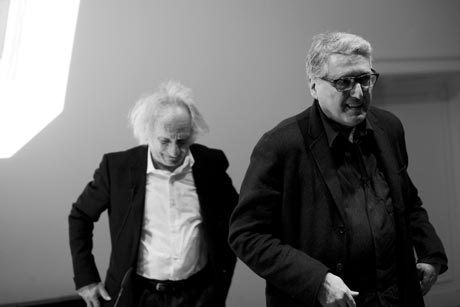
13.02.2013 with Prof. Dr. Boris Groys
Photo: © Steve Bergmann

30.01.2013 with Prof. Dr. Hans Ulrich Reck
Photo: © Steve Bergmann

16.01.2013 with Prof. Dr. Elisabeth von Samsonow
Photo: © Steve Bergmann
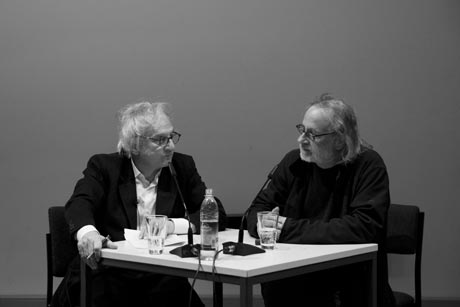
05.12.2012 with Florian Rötzer
Photo: © Clemens Jahn
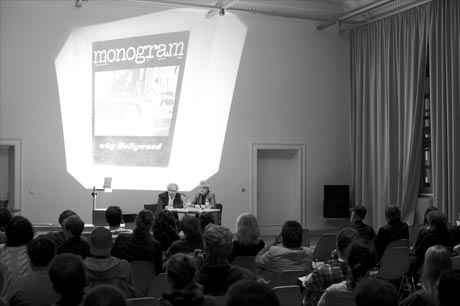
21.11.2012 with Prof. Dr. Thomas Elsaesser
Photo: © Steve Bergmann

07.11.2012 with Prof. Dr. Joachim Paech
Photo: © Steve Bergmann
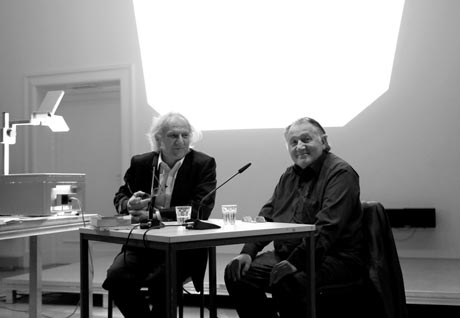
24.10.2012 with Prof. Dr. Peter Weibel
Photo: © MONOKROM
Questions for Boris Groys 13.02.13
Debating a topic both seriously and explicitly means taking a risk, said Boris Groys in 2004. In the late 1940s and 1950s it would have been an inevitable risk for McLuhan to talk about media. He managed to do so with great success. His courage came at the right time. Can it still be risky for us today to talk about media? Or do we solely fulfil a systemic function, since media has long ago become part of the order, in which we are living? Isn’t every word on media at the same a confirmation of its power?Trying to get to the heart of your Antiphilosophy (2009), I would suggest, that it turns philosophical thinking from a gesture of critique into a gesture of command, an instructing gesture. Antiphilosophy is in the know. Could we possibly attempt to replace philosophy with media? Would we then still be dealing with a turn, from contemplation to order? (A Benjaminian thought: from the aura to a test situation? Also taking the binary into consideration, with the I Ching and Leibniz.)”Media theory is not so new”, Boris Groys keeps insisting. In fact, concepts such as the cyborg were not invented on the West Coast of the United States, instead they are to be found many decades earlier among the Russian Biocosmists and Immortalists. They were only named differently. This means in consequence that thinking media, not necessarily in the sense of a systematic theory, is significantly older. Where would you locate some of the origins of your own thinking? In the spiritism of the 19th century? In Freud’s and Stekel’s oneiromancy? In the psycho-environment of industrialism? Or even in the late renaissance living machines?To you, one of the most important functions of media (as apparatuses, as equipment) is to help people adapt to machines. As Oswald Wiener depicts it in his bio-adapter, media makes us bearable for a world permeated with media. (And the other way around, too: make the world more endurable for us.) Two questions arise: a media-theoretical thinking should have been on the agenda ever since we began to act like machines, that is to follow programs/instructions? Can the man-machine dualism sustain as a useful concept, if they both function splendidly together interdependently?During the Russian revolution technical media, their development and appropriation were more than just items on an agenda. Media-related questions were urgent: the sound collage with record players (Dziga Vertov), the film montage (Kuleshov), radio propaganda (Lenin), electronic TeleVision (Boris Rosin), music (Theremin), chronophotography (Gastev)… even poetry (Kruchenykh, Chlebnikow) was affected by media. You studied in Leningrad were many of these developments originated. How present were such medial attractions during your studies? Did they have any significance during your study of philosophy in the late 1960s?In his late 1920s portrait of Bolshevism, Fülöp-Miller depicts a still primarily agricultural Russia with technology being especially present through its deficiency. Did the great affinity for technology during the revolution and a young Soviet Union correspond to an every day experience or was it much rather a projection? Was its radicalism an expression of a certain yearning for technology?In one of you most important exhibitions (Schirn, 2004) you juxtaposed the Western “fantasy machine” (Fülöp-Miller) with the Eastern “dream factory communism”. How similar were these two celluloid economies of desire in the 20s? And how similar are they today (observed from New York)?You were intellectually socialised in the Soviet Union, among others through programs and positions in structural linguistics; you worked in Moscow as linguistic researcher. In many passages of your media theory, for instance, where you are specifically dealing with the relationship between signifier and signified, de Saussure’s famous Geneva lectures seem to be very present; the same goes for Jakobson’s principles of the disassemblement and reassemblement of complex phenomena, which seemed to play a significant methodological role in other passages, too. How relevant has structural thought become in your own philosophy? Would you consider your thinking and writing (in a very Barthesian sense) structuralist practice?Tonight we are at an institute for »time-based« media. To my surprise G. E. Lessing’s classic treatise on Loocoon comes up in your Antiphilosophy quite significantly, discussing the difference between spacial media such as sculpture on one hand, and poetry on the other, with its “articulate sounds in time”. Your review of Lessing is critical, yet obviously respectful. Where does your fascination with Lessing’s 1766 image critique stem from? What is its medial essence? Could your conception of artworks as “grimaces of »the desire to speak«” (Antiphilosophy, p. 241) possibly be derived from it?Marx wrote a Critique of Political Economy; at the same time you define his method – the mode of thought this critique is built upon – as Antiphilosophy par excellence (thus affirming it at the same time). It consists of rules and commands. How handy and useful is the historical dialectical materialism for Boris Groys’ cultural critique?Pleasantly there is no book on new media by Boris Groys (hardly anyone knows anymore what that term is supposed to mean anyway). But there is a monographic treatise on the new as well as a monographic phenomenology of media. Both discourses are strongly tied together. Would you consider your treatise on media as the logical continuation of your treatise on the new?Let’s talk about the relationship between the sacred and the profane space, which you define as archive on one hand, and on the other as a remainder of that “which has not been collected yet”. (Some people would call the latter reality, life outside the depot.) The economy being processed between these two spaces, may be called waste management. “The value of a new thing … in the archive, is a function of its worthlessness in everyday reality.” (Under Suspicion, p. 5) How is the relationship between these two spaces to be thought? As an equilibrium, with the valorisation of the worthless and the devaluation of the precious, as suggested in your chapter on exchange in the New? How porously are these topoi to be imagined? How strongly are they linked with each other?Isn’t one of the functions of (mass) media precisely to profanate sacred spaces (such as the archive or the museum)? Which also means: to make them accessible and transparent? Exploit them as a resource for new artistic productions?From a semiological perspective you interestingly provide a twofold definition of the exterior: on one hand it is being defined by the profane outdoor space, which bears no secret whatsoever for the observer. On the other hand there are “sign carriers”, that you locate topographically within the archive, yet they remain external to that, which submedially rumbles about in the archive – offering us a surface of perception, underneath which we expect to find truths. (This would probably be the media.) With this distinction, aren’t you touching one of the basic problems of the avant-garde dealing with media?”Black Square does not present itself as simply a picture among many other pictures but as a sudden revelation of the hidden picture carrier …” (Under Suspicion, p. 83) Does this mean, that revolutionary painting in Russia had already anticipated, what later e. g. became constitutive for experimental film? Something one may call a threefold coding: I am showing something while showing that I am showing something and how I am showing it? (“The Medium Becomes the Message”, Under Suspicion, p. 69 ff. / “The revelation of media procedure”, Antiphilosopy p. 227)Maybe a few words on Clement Greenbergs “Modernist Painting”, 1960?In your discussion of Georges Bataille’s notion of expenditure as an alternative concept to both the capitalist dictate of accumulation and the unconditional paradigm of productivity of the socialist economy – and following Derrida –, you present the idea of an impossible gift: “the giving of time” (Under Suspicion, p. 132). Time is the only thing we consistently do not possess. Time has us. Could you expand on this peculiar gift and its meaning for us as time machines?Agamben demands a directed profanation of sacred-felt entities such as telematic networks. Following your observations from the mid 90s, we have long been surrounded by phenomena of the religious turned ordinary. Most people today associate Jacob’s dream of the rise to God and the advent of the angels much more with Led Zeppelin than with the Bible, the greatest miracles for many young moviegoers today are new Apps for their smart phones or surprising special effects in the movie theater (as indicated by Hent de Vries in your exhibition catalog for Medium Religion). Do these two tendencies come with a general profanation of the sacred?Do you see the necessity of a counter movement as more and more postulated by Virilio and Latour: towards a sacralisation of the conditions and events themselves? Do we need to return to the sacred? Or is a concept as such necessarily tied to that of the apocalypse?Is an apocalyptic thinking necessarily a Christian/Catholic thinking? What about dialogical Buddhist or Jewish thinking? (The catastrophe has not yet taken place, neither has salvation.) “We are unable to observe without becoming suspicious” (Under Suspicion, p. 174) and verbalising suspicion. In your Karlsruhe lecture you mentioned that: “In media theory the subject can only be a spirit”, the spirit articulating itself through man as “well-trained language machine”, using their bodies as media. Are these media at all surmisable as silent anymore? Might silence be the most adequate way to express a media critique?At the sight of which images does Boris Groys turn speechless?
Questions for Hans Ulrich Reck 30.01.13
Studying philosophy and art history in Tübingen in the 1970s did not automatically involve being confronted with the French apparatus-theory, the early fluxus artists somewhere between New York, Paris and Cologne or the first West German film and media theorists from Berlin. When did which theory-events or lectures stimulate you to reflect more intensely upon media and the interrelationship betweens the arts and media? Which disciplines were peculiarly important: was it primarily philosophy? Art theory? Or even linguistics and literary studies?What about the practical arts? Were you contemporarily paying attention to the actionists in Vienna?How about experimental film? Was the US-American and European film Avant-garde present at all during your studies?You studied with Ernst Bloch. How strongly did you engage with critical theory during your studies (Adorno / Horckheimer, Benjamin, Marcuse)? How meaningful was their most important writing that had any relevance for media (Dialectic of Enlightenment, The Artwork…, One dimensional man) to H. U. Reck?How important were – and still are – the German speaking systematic thinkers of the technical and social aspects of communication such as Habermas or Luhmann to you?How important were linguistics and semiology for your early media-thinking (also in the sense of film semiotics, compare for instance the debate between Pasolini and Eco on the relationship between reality / the real and the sign – the famous Pesaro film festival of 1965)?Which meta-theoretical and ideological references were peculiarly powerful during your studies and at the time when you started to write? How important were the various versions of a critique of the political economy, how familiar and challenging was Sartre’s political existentialism?Sartre and the new French spirits were anything else but peaceful with each other. How strongly did structuralism – and especially the French post-war version of it – influence you (with Levi-Strauss, Lacan, and later Foucault, Derrida)? When did they begin to gain relevance for your thoughts?The translation of Deleuze’s and Guattari’s Mille Plateaux (1980) took quite a few years here in Germany (1992). Did your Swiss background – speaking and reading French fluently – give you the advantage to already having read this compendium of a logics of the manifold in French?How important was this peculiar proliferation in these fields of events of reasoning and practice for your own theoretical work?When and in which way did the post-structuralists become interesting to you (Lyotard, and later Baudrillard and Virilio)?Extending this discussing into present day: what intellectual stimulant do Badiou, Ranciere, Nancy have to offer for you? How would you explain their late success or at least the amount of attention they have been getting for several years now?Let us now move a bit closer to the arts and their interrelations with the media. Today it seems as if it were the most common thing in the world for art theorists and historians to engage with technical or even time-based images. For over 10–15 years now, research projects have been installed, that are worth millions of Euros, dealing with the technical image, the iconic turn or a science of images. The fiercest critics of a mediatization of the arts during the 1970s and 80s today belong to a well-approved group of managers of knowledge in the vast field of art and media. Does that astonish you?Let us try to reflect upon what happened in the 1990s, this exciting decade for the interrelationship between art and media. How did art theory and art history change through the confrontation with the constantly growing power of mass media on one hand, but also with new constellations for the experiment? (Networks and cooperations before the invention of social media as a buzz word.)During this period, did art theory basically turn into media theory for you? Or were the media in fact nothing but a contextualization of the arts, that was to be taken seriously as a challenge?You answered the at that time newly emerging image sciences with scepticism, which then turned into explicit criticism, at the point were the image sciences were adapted in Germany as »Bildwissenschaft«. What was gained from eliminating art from a scientific involvement with images? Was there any gain at all?After the first crash of the new service and high-tech economies, the goal-orientation of the media and their systemic character became more and more obvious; media art was established and integrated into apparatuses, it became indispensable. Its subversive potential took a backseat in favour of a supervisionary presence. How did this development take place? How were you involved?Last year you devoted yourself acutely to Pier Paolo Pasolini, including a publication. “Partisan of an ever particular truth” – is how you characterise him in the “philosophical portrait” released on CD. What is so intriguing about this unique political and artistic figure of the 20th century? And: do you grant both a chance in the future: the partisan-like and the particular? Is Pasolini solely a figure of the past?Which are future the demands of a media thinking? Do you see any possibility to extend a concept of truth like Pasolini’s into a future, where the media have adapted a systemic character?
Questions for Elisabeth von Samsonow 16.01.2013
Totem, fetish, sculpture, paint, text body, ether… Elisabeth von Samsonow’s media theoretical reflections seem to be drifting along the lines of physical objects / phenomena. Are they indicating a particular kind of media materialism, some sort of magically laden materialist media theory? Or is this the expression of an artist necessarily requiring sensual material for her thinking in-between? Thinking through material? Body thinking?How is the relationship between working as an artist and as a philosopher depicted in Elisabeth von Samsonows (creative) practice? How can we imagine this relationship in day-to-day life? Are the two undissolvably intertwined, do they coexist, or is it more of a chronological sequence?Poet philosophers have been playing a crucial role as authorities in your references, notably more recently with Nietzsche for instance. How important is such a tight connection between poetry and philosophy for Elisabeth von Samsonow?Were there any texts or events in your early intellectual socialization, which sustainably influenced your thoughts on art and media? (Parallel to our reading of Lessing on Laokoon, Benjamin’s essay on the artwork and Brecht’s Short Organum for the Theatre in Berlin)Which were the most dominant meta-theoretical models during your studies at the University? Where there any at all? How important was Adorno’s and Horckheimer’s Critical Theory? Did structuralism play an important role? Or the culturalist influence from Great Britain (early cultural studies)? Or the Parisian apparatus theory? Both turned out quite fruitful for early gender studies.Who were the heroines and heroes of your desires to read and learn as a student?What significance does an ebullient spirit such as Giordano Bruno’s have – who has been accompanying you for over a quarter of a century – for your thinking? As well as the way you think the arts and their media?The insecure, doubting subject who tries to gain safe ground by exploring the world: as a frontispiece for his Magia naturalis and as a signet for his academy of secrets Giovanni Battista della Porta used an impressive engraving in the 16th century, showing him fight with his own reflection in the mirror. Before you change the world you have to recognize yourself, reads della Portas message directed at Demokrit… Is there a connection for Elisabeth von Samsonow, between such a (weak) renaissance identity and what contemporarily can still be called subjectivity? Or has the latter dissolved already in narcissism and its medial allocations?Were James George Frazer’s “Goulden Bough” or his superb text on “Totemism and Exogamy” already part of Elisabeth von Samsonow’s early readings, or did they come in later together with a growing ethnological and anthropological curiosity?”…every plastering of an object with soul, turns it potentially into a lower organism, into a specimen of a simplified species of soul possessors… the weak mammal gaining ground” – these fragments come from your concept of the apparatus, which is linked to theories of totemism. Media theory as a totemistic theory – what are the features of such an approach?Does the concept of the artifact, the apparatus as organum: instrument and organ at the same time, incorporate a certain dimension of McLuhanism (with all technology as an extension of the biological body)? Or do concepts such as Kapp’s “organ projection” from his Philosophy of technology (1877) play a major role?How significant were the so called French master thinker after World War II for your intellectual socialization? Which role did for instance Claude Levi-Strauss’ ethnology and anthropology play during the development of your ideas?One of your monographs explicitly deals with Gilles Deleuze & Felix Guattari already in its title. Before we talk about “Anti-Electra” in more detail: when and how did the shocking insights of the “Anti-Oedipus” and the confusing planes of incident of “A thousand plateaus” break into your intellectual world? Or was there no break-in? Did they fit in without a break?The antique myth depicts the character of Electra iridescent yet inconsistent. She is the personification of multiplicity: daughter, girl, mother, murderer (or at least assisting the murder of her mother), energetic troublemaker, interferer, passionate mover, anima/soul (which correlates to the animal), but at the same time she is automatos, moved herself… which dimensions is Elisabeth von Samsonow interested in, in her outline alternative to the “Oedipus-Complex”?While reading your “Anti-Electra”, not only did we think we discovered an emphatic pleading for intervening and becoming, but also for a particular kind of profanization (also in the sense of Agamben): due to her playful character, for Electra artifacts are important as instruments, as means to discover potential spaces (Winnicott), which childhood offers… Are media means to expand childhood (especially the pre-oedipal phase of it) across the entire duration of an individual life?Schizophrenia as a constant transgression of ego-boundaries: in the early theories of schizophrenia, electric (tele-)machines play an important role as (male) instruments of power, as destructive and controlling authorities (Victor Tausk influencing machines). Is this negative connotation relevant for your Anti-Electra? Is schizophrenia the normal condition of a sociality interpenetrated by media?Is Elisabeth von Samsonow’s media theory a game theory? (Huizinga / Caillois?)Over and over your text are about – how could it be any different with media theoretical concerns – the in-between: that, which rumbles about between the humanoid and the apparative, between the natural and the artificial, the celestial and the terrestrial, the having-been-born and the giving birth – the floating, the becoming, the beaming (expressed in the colors of sculpture, the albedo): Would it be absurd to call Elisabeth von Samsonows’s considerations as prolegomena to a media theory of angles? Is your girl theory a theory of angles?The theologi electrici, the electric theologists of the 17th and 18th century often spoke about god’s presence in the world, expressed through electricity as a principle and power. Does your Electra have a similar character? Can we imagine her as an oscillograph, displaying the flow of energies and its rhythms?In the chapter “Tele-commando/media puberty” from your book on Egon Schiele, you write that “multiplicity guarantees the principle of arousal” (82). Deleuze’s and Guattari’s “Thousand Plateaus” can be considered an enthusiastic sequel to “Anti-Oedipus”. “A Thousand Plateaus” can be interpreted as an endeavour to develop a logics of the manifold, an operational theory of multiplicity. Would I misinterpret your book on Egon Schiele as an enthusiastic sequel to your “Anti-Electra”?
Questions for Florian Rötzer 5.12.2012
How does Florian Rötzer see himself 20 years after The Medial and the digital – dispersed remarks and advice from an information-processing system as well as Digital appearance (»Schein«) – the aesthetics of electronic media? How about the irritation of the information-processing system today? Is it still lasting, or has it given way for more practiced approaches?How do you work as the chief editor of Telepolis? Amidst making books and newspapers, extremely fast and slow text cultures, Blogs and the various social networks: does your everyday work exclusively take place online?Which were the reasons for you in the 1990s to engage with communication on the web with such intensity? Were you bored by the discourses that were taking place offline? What was the challenge – some sort of immediate contemporaneity throughout the development of a new cultural technique?Or was it strict obedience to Kittler’s technical a priori? Or were you much rather following Baudrillard’s suggestion, that the hegemony of the symbolic can only be opposed by intervening in the symbolic?Is there a way to draw connections between a philosophy of dialogue in the tradition of Martin Buber, and a reality of protocols, services, browsers and cloud-operators? What is your experience with the dialogical nature of telematic communication?Which role does art play in your work life today (neither art critique not art philosophy, but actual »art production«)? Do you participate in artistic processes? Inside / outside of the internet?During your education at the university you were still being taught the »classical« German post-war philosophers (such as Taubes or Hübner). How did you experience the new thinkers from France »breaching« (at least from our perspective) German intellectual everyday life?Which role did this band (in a Deleuzian sense) play in the 1980s (after »the leaden times« and the »German autumn« of the 1970s)?”…thinking as a sort of challenge of what it is not (yet) capable of conceiving” – were the new telematic conditions that, what thinking was not yet capable of conceiving?Through the means available to you (books, »Kunstforum«, conferences, panel discussions) you strongly supported the new charismatic thinkers of media and civilisation, among them especially Vilém Flusser. How would you retrospectively estimate his function in developing a kind of mediaThinking?During the epistemic transition from a strongly structuralist and marxist critique of media towards a »post-modern« way of perception, the concept of »appearance« (»Schein«) always played a crucial role (including your own writing). On one hand your fascination with the new surfaces was quite obvious, on the other, a sincere intellectual one had to retain critical reservation or even draw apocalyptic visions of a visual cancer on the wall, generated by technical images. Did you experience this as a paradox, or was this tension much rather created, retained and even nursed intentionally?”Only that which has already become an image, seems to possess the character of reality today…” (Florian Rötzer, 1990). How does this formation of the image of all reality influence all those practices which have primarily been dealing with the creation of images? Did they perceive these dramatic changes at all or was that restricted to only a small group of specialists and early media artists?In 1990 Peter Weibel writes “for a psychotisation of perception” and states: “In succession of Foucault one could write a beautiful piece called: the birth of the gallery out of the spirit of the prison.” The rhetorics of extraction from the 1960s until the 1980s led to a massive movement of retraction of media arts into the traditional art spaces in the 1990s and onward. Would you consider this more paradox or rather consistent?One of your specialities are the correlations between urban and medial structures, or, simplifying it a little today: of the city and the internet. More and more people live in the cities. Fast communication, once invented for the city, is now taking place within telematic networks. What are the consequences for urban agglomerations? Will they be decentralised because of the internet, scattered into islands? Will they be virtualised as social places, which also means: voided as places themselves? Or will they turn into bazars, places of exchange for all kinds of junk, including emotions, while proper business takes place online?And of course the other way around: how are telematic communications engraving themselves into urban everyday life? Are they generating new urban phenomena, which we hadn’t known before? How does organisation of attention through the internet in the cities influence e. g. crisis areas?Where do cities and networked communications intersect? Loneliness, anonymity, traffic… what type of specific sociality is emerging in-between the various dispositifs?
Questions for Thomas Elsaesser 21.11.12
Beyond all difficulties that naturally occur with such categorizations – which du you prefer: to be called a film and cinema scholar, or rather a media scholar?You began your studies particularly with English and German literature as well as comparative literature studies. Did your engagement with film and the cinema follow up on an extended concept of narration and poetry? Or were film and the cinema naturally part of your interest in literature?How important was the transgressiveness of comparative studies to you?You mentioned that your excitement in analysing the cinema was an expression of the attempt to understand the young Godard…?Was there a way in which the various perspectives of the cinema and film were being thought together professionally as well as trans-disciplinarily (sociology, psychology, aesthetics)? Which lines of thought and discourses participated with efficacy in the 1960s and 1970s?Let us talk about the various traditions in more detail:Which way of working and thinking was typical for the Birmingham school at the Centre for Contemporary Cultural Studies? Did Hoggart, Raymond Williams or the Marxist Edward Thompson influence your work?Were Stephen Heath or Stuart Hall still playing any significant role in your development?Which role did linguistics and semiology play in your early intellectual socialization? How important were they in the early English scence?At the Berlin Technical University we were literally bullied with Chistian Metz’ Grand Syntagmatique of narrative film. Was that a new type of language that had to be adopted?Was the analysis of film an introduction to a new cultural technique, a different way of physical thinking (Körperdenken) and presence of mind?Did you and your environment notice much of the French apparatus theorists (Jean Baudry, Jean-Louis Comolli, Marcellin Pleynet) around 1970 in Great Britain?During your time in Paris in 1967/68, were you already under the influenc of the new structuralist writings which had just been published – The Order of Things by Foucault (1966), Derrida’s Grammatology (1967), The Society of the Spectacle by Debord (1967)? How long did it take until people in Great Britain found out about them?Did Roland Barthe’s Mythologies play any significant role for you?Which changes were caused by Baudrillard, Virilio and currently for instance by Debray’s Mediology?Would you consider the contemporary Parisian thinkers an important reference (Badiou, Nancy, Rancière)?Where does your particular interest in the German cinema of the 20th century »narrative avant garde« stem from, or more precisely, in filmmakers who narrate German history?How and when did psycho-analysis find its way into your work and how did it influence the construction of your theories? Was psycho-analysis treated as critically as semiology was?Would you consider Great Britain the place of origin of feminist cinema?Which role did appliances, machines and aparatuses and their availability play in Norwich and Amsterdam regarding an understanding of their specific shapes and the sensual experience of media?How was the relationship between theory / reflection and praxis thought in Norwich and Amsterdam? How important was mediaMaking for mediaThinking?Does the establishment of media studies as a an academic major subject make sense in your opinion? Are the visual studies in the U.S. following a comparably more generous approach?Is there a future for film and cinema studies as an autonomous major subject and field of research?What could a typology look like which differentiates between film and media studies?
Questions for Joachim Paech 7.11.12
Which role did the Berlin art scene and its institutions play for your work in the theatre arts in the late 1960s early 1970s? For instance the NGBK (The New Berlin Society for Fine Arts), the Literary Colloquium, the Arsenal movie theatre, the the development of Karl-Heinz Stockhausen’ spherical auditorium at the electronic studio of the Technical University?Which subjects, lines of thought and discourses were involved in the development of mediaThinking and which perspectives were thought together?How important were papers from the literary studies – such as Lessing’s Laokoon – for your understanding of time-based media?What about the performing arts and fluxus?Which role did linguistics and semiotics play regarding you intellectual socialization?How significant were the first appliances for hearing and seeing, such as tape or video recorders, for your sensual experience but also for the analysis of media?How strongly were you as person but also media education in general influenced by the early films of Jean-Luc Godard, such as Breathless or Alphaville?In which way did the early apparatus theorists such as Baudry influence your thinking? Was there any contemporary reception at all in Germany?Was the »cultural marxist« avant garde a purely French phenomenon?Did the (post-) structuralists, such as the early Foucault, Derrida or Barthes play a significant role for you?Marx, Adorno / Horkheimer, Brecht, Habermas: Who supplied you with the most important meta-theoretical references?Which role did Freud, Lacan and psycho analysis play in the foundation of your theories?Do you consider yourself a film or media scholar?How would you rate the process of the academic establishment of media studies? When did that take place?Does it make sense to talk about a Berlin school I & II or for instance talk about a Constance school? How would you profile those?How did you as a cinema scholar experience the paradigm shift towards the internet as a »master medium«? What significance does the internet have for you today?Due to the short historical lifespan of a general concept of media, you are proposing a program-science in presence of computer-based forms of communication…?
Questions for Peter Weibel 24.10.12
Let’s start with an aspect encompassing most of your work: at the beginning of Territory and Technology (Territorium und Technik, Merve 1989) you mention how important the phenomenon of movement is to your world view: movement of thought, movement of objects and bodies. There is nothing dead. In Peter Weibel’s opinion, what meaning do movement, kinetics, dynamic space-time have within a man-machine-relationship?Did Peter Weibel perceive Lessing’s Laokoon as a media theory before media?What meaning did text, did language have for Peter Weibel when he began to engage with the Vienna art scene in the mid-sixites (with his typewriter, pen, paper, tape recorders and once in a while using his own body)?Did the material, the physical function of technology play an important role from the beginning?Buzzword »Linguistic Turn«: Which role did linguistics, did semiology play? (The rediscovery of de Saussure, Wittgenstein, the Vienna circle, the Prague school, Peirce?) Some kind of intellectualization of art? Structuralism: Levi-Strauss, the young Foucault…How important was psycho-analysis for the Viennese actionists? Which role did it play for Peter Weibel?Was the gender discourse part of these activities, or was it treated independently from psycho-analysis?How important was The Critique of the Political Economy? How important was Marx (before Baudrillard)?Was there an exchange between action art and Fluxus? Or did everybody do their own (epistemic) thing?Claude Shannon, Alan Turing, Ross Ashby… the discovery of cybernetics and automata theory arrived comparably early to the German speaking chapter of media theory. Enhanced with illustrations by Dieter Roth, in 1974 Rogner & Bernhard published Peter Weibel’s and Franz Kaltenbeck’s German translation of Shannon’s & McCarthey’s Automata Studies, originally from 1956. What did it mean for Peter Weibel as an artist to deeply engage with turing machines and intelligence amplifiers? Why make the enormous effort to translate these texts (into German)?Was that already a plea for programming in the arts in the early 1970s? What is Peter Weibel’s current opinion on this issue, now that programming has already turned into a common cultural technique?The massive pictorial complex – the debate of which had meanwhile been going though severe changes under the impression of machine theory – was that an expansion or much more a removal of the effigy (Abbild), dissolution of the statics? Interaction / image generation und image representation as a process?How would you describe your past and present relationship with the Apocalyptics of Media Theory (Baudrillard and Virilio), who you had been (or still are) friends with? Is it possible for teleology and an open concept of action to coexist?
The »Forum on the Genealogy of MediaThinking« is a series of events hosted by Prof. Dr. Siegfried Zielinski at the University of the Arts Berlin, department for media theory (focus »Variantology / Archaeology of Media«) in collaboration with Daniel Irrgang and Clemens Jahn. Selected protagonists are introduced in a series of panels, which take place every two weeks. Subsequently an evaluation of the talks will be published. The talks are open to the public and take place at the auditorium of the UdK Berlin Medienhaus. How did the idea to think and treat aesthetic products as media emerge? Which sciences and arts were involved in the beginning? How is the (early) dominance of linguists and philologists to be explained? How did semiotics and media studies act towards each other? Which meaning did informatics have? Which role did the experience of German fascism play in the development of media thinking? How meaningful was the utopian dimension of early media thinking? Which were the consequences of the establishment of media studies as an independent discipline at universities? Does it make sense, to talk about a »Berlin school of media studies«? How do the first, second and third generation of media thinkers differ from one another? How did mediaThinking change with the development of technological dispositifs? Is there a specific mode of thought for the cinema, television or the internet? Which tendencies are currently to be foreseen regarding a future mediaThinking?
These are just a few of the questions to be asked in the »Forum on the Genealogy of MediaThinking«. Further questions will emerge and be developed by the participants during the course of our experimental research. The genealogy of media thinking – in Europe and the whole world – is a desideratum. This seminar aims to write nothing less but a small genealogy of this peculiar way of thinking and designing culture. Interdisciplinarity has been part of which since the beginning. Naturally we act accordingly.



Russian edition of Archaeologie der Medien (2002) / Deep Time of Media (2006) Published by GARAGE - AdMarginem, Moscow 2020 ***
Archäologie der Medien / Archaeology of Media Second edition of the Chinese translation Publisher: The Commercial Press Beijing, 2019 ***














































